Showcase area
- Pre-1900
- 1900-1909
- 1910-1919
- 1920-1929
- 1930-1939
- 1940-1949
- 1950-1959
- 1960-1969
- 1970-1979
- 1980-1989
- 1990-1999
- 2000-2009
- 2010 - present day
1823 - Charing Cross Hospital Medical School
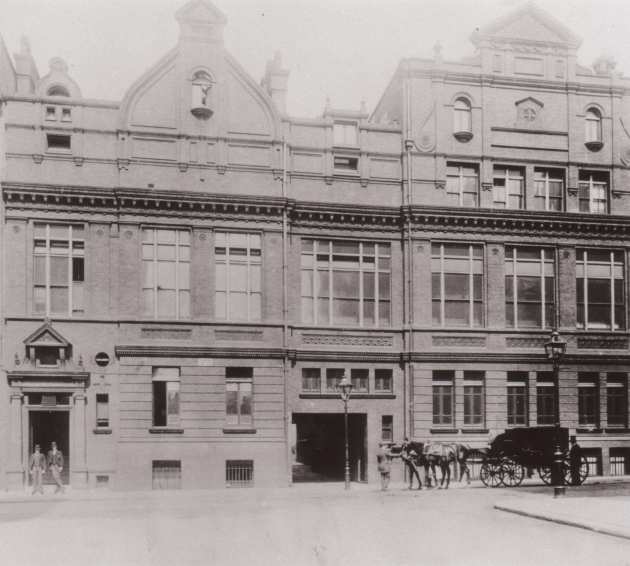 The origins of the Charing Cross Hospital Medical School can be found at a meeting of gentlemen at the home of Dr Benjamin Golding to discuss setting up a charitable institution to be known as the West London Infirmary. This was to be a hospital with training facilities, to supply the want of a University, so far as medical education is concerned. Golding drew up a medical education plan in 1822.
The origins of the Charing Cross Hospital Medical School can be found at a meeting of gentlemen at the home of Dr Benjamin Golding to discuss setting up a charitable institution to be known as the West London Infirmary. This was to be a hospital with training facilities, to supply the want of a University, so far as medical education is concerned. Golding drew up a medical education plan in 1822.
The hospital opened in 1823 in Villiers Street and in 1827 was named Charing Cross Hospital. New Medical School facilities opened in Agar Street in 1834 with 22 students, and again in Chandos Place in 1881. The School was enlarged in 1894, adding physical, biological and pathological laboratories and the curriculum was lengthened from 4 to 5 years.
19th Century alumni from the School include the explorer David Livingstone who was a student there between1839-1840. T.H. Huxley took his medical training at the School, publishing his first paper in 1845 whilst a studentOn a hitherto undescribed structure in the human hair sheath’. It describes the inner layer of the root sheath of the hair follicle since known as Huxley's layer.
1834 - Opening of Westminster Hospital Medical School
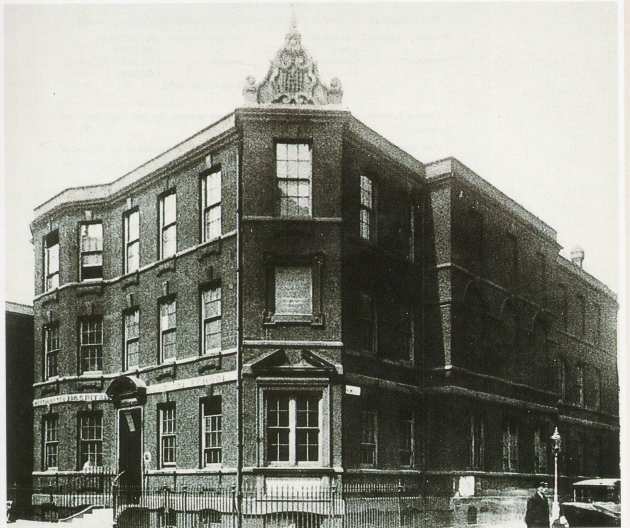 The Westminster Hospital Medical School began in 1834 and, by 1837, each surgeon was allowed three 'cubs', as the students were known. Formal development for training and provision of a building in Dean Street were made in 1841. After financial difficulties in 1847-1848, the School was re-launched in 1849 and a museum of anatomy established.
The Westminster Hospital Medical School began in 1834 and, by 1837, each surgeon was allowed three 'cubs', as the students were known. Formal development for training and provision of a building in Dean Street were made in 1841. After financial difficulties in 1847-1848, the School was re-launched in 1849 and a museum of anatomy established.
The lecturers effectively subsidised the students as they financed the School by paying into the School fund an amount equal to the value of their Chair. A purpose built School behind the hospital was opened in 1852, but as the School expanded, a new building was required and opened in Caxton Street in 1885./
The School's 19th Century famous alumni include John Snow, anesthetist and epidemiologist who administered chloroform to Queen Victoria during childbirth in 1853 and 1857. He identified the source of the 1854 Golden Square outbreak of cholera as being the water supply in Broad Street. The water pumps were shut down and the epidemic subsided.
1845 - Creation of the Royal College of Chemistry
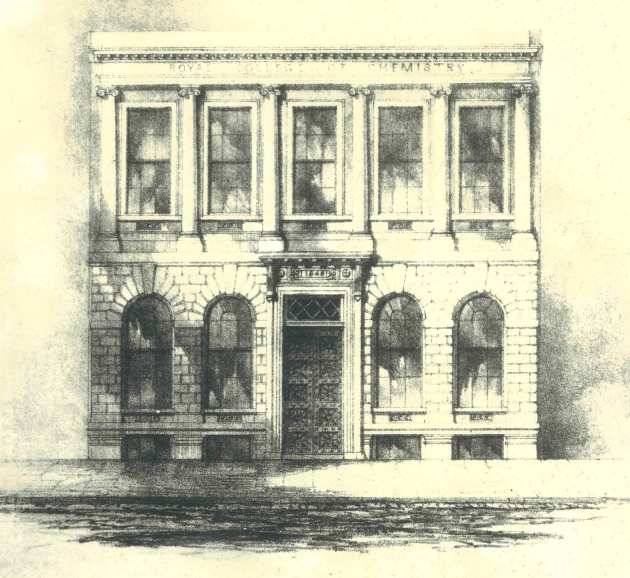 The Royal College of Chemistry was founded in 1845 by subscription as a necessary national resource for industrial and technical development. Royal patronage came from Prince Albert, who was President of the Council. The founders, John Lloyd Bullock and John Gardner appointed August Wilhelm Hofmann as the first Professor. He held the post until returning to Germany in 1865.
The Royal College of Chemistry was founded in 1845 by subscription as a necessary national resource for industrial and technical development. Royal patronage came from Prince Albert, who was President of the Council. The founders, John Lloyd Bullock and John Gardner appointed August Wilhelm Hofmann as the first Professor. He held the post until returning to Germany in 1865.
The College was situated in Oxford Street, backing on to Hanover Square. In 1853 the Royal College of Chemistry merged with the Royal School of Mines based in Jermyn Street, though teaching continued at the Oxford Street premises until the removal of much of the School of Mines teaching to South Kensington in 1872.
1851 - Creation of the Royal School of Mines
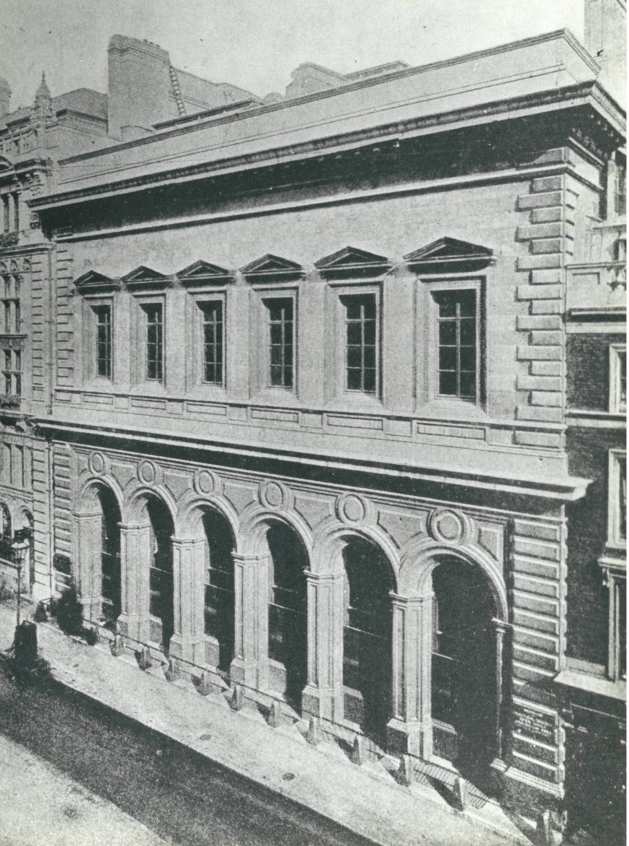 The Government School of Mines and of Science as Applied to the Arts was founded by Sir Henry de la Beche in 1851. He also largely founded and was Director-General of the Geological Survey of Great Britain, responsible for the Museum of Economic (later Practical) Geology, the Library of the Museum and Survey and the Mining Record Office.
The Government School of Mines and of Science as Applied to the Arts was founded by Sir Henry de la Beche in 1851. He also largely founded and was Director-General of the Geological Survey of Great Britain, responsible for the Museum of Economic (later Practical) Geology, the Library of the Museum and Survey and the Mining Record Office.
De la Beche created a school which laid the foundations for the teaching of science in Britain, and which has its legacy today at Imperial. Prince Albert was a patron and supporter of the later developments in science teaching, which led to the Royal College of Chemistry becoming part of the Royal School of Mines and to the creation of the Royal College of Science and eventually to these institutions becoming part of his plan for South Kensington being an educational region.
Listen to Dr S W Smith describe, in 1957, a memorable lecture in the RSM that he attended in 1897
1854 - St Mary's Hospital Medical School established
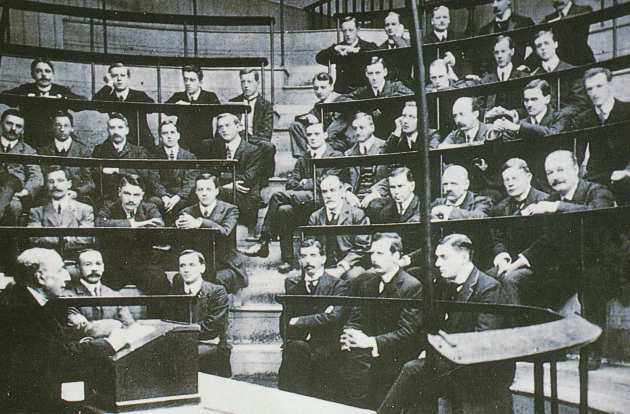 St Mary's Hospital was founded in 1845 by Samuel Lane, surgeon and anatomist, and from its inception was intended to be a teaching hospital. It opened in 1851 with two students. The Medical School was founded in 1854 and the number of students soon rose to 40. Samuel Lane donated his collection of specimens for the pathological museum at the hospital.
St Mary's Hospital was founded in 1845 by Samuel Lane, surgeon and anatomist, and from its inception was intended to be a teaching hospital. It opened in 1851 with two students. The Medical School was founded in 1854 and the number of students soon rose to 40. Samuel Lane donated his collection of specimens for the pathological museum at the hospital.
The School gradually grew and in the 1880s there was a much needed expansion of facilities, with pathology laboratories particularly being enhanced.
Famous alumni include The Lien Wu who entered the School on a Scholarship in 1899. He returned to China and became Director of the Imperial Army Medical College, was Chief Medical Officer to the Manchurian Plague Service and an historian of Chinese medicine.
Sir Almroth Wright joined St Mary's in 1902 as Director of the Inoculation Department, later the Wright Fleming Institute until 1946. His great contribution to medicine was vaccine therapy, which was to be so effective in saving the lives of men of the allied armies during the Great War.
1881 - Creation of the Royal College of Science
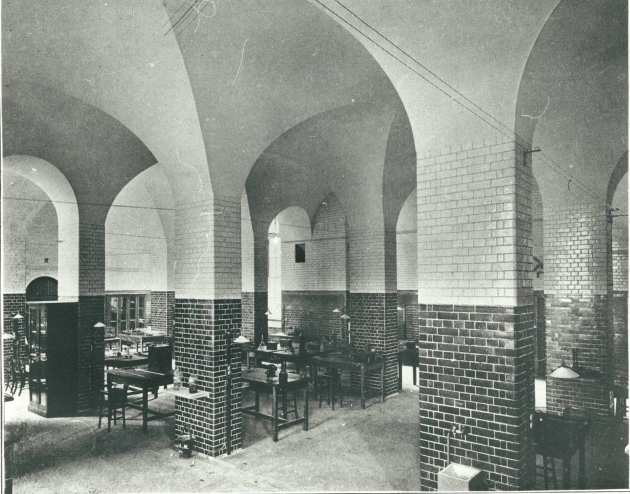 In 1881 the Normal School of Science was established which quickly changed its name to the Royal College of Science. The title Normal had been intended by T.H. Huxley to indicate the high status of the School as in the Ecole Normale in Paris. This did not translate well into the English language and was altered in 1890. The main objective was to support the training of science teachers (other students were admitted) and to develop teaching in other science subjects alongside the Royal School of Mines earth sciences specialities.
In 1881 the Normal School of Science was established which quickly changed its name to the Royal College of Science. The title Normal had been intended by T.H. Huxley to indicate the high status of the School as in the Ecole Normale in Paris. This did not translate well into the English language and was altered in 1890. The main objective was to support the training of science teachers (other students were admitted) and to develop teaching in other science subjects alongside the Royal School of Mines earth sciences specialities.
1884 - Creation of City and Guilds College
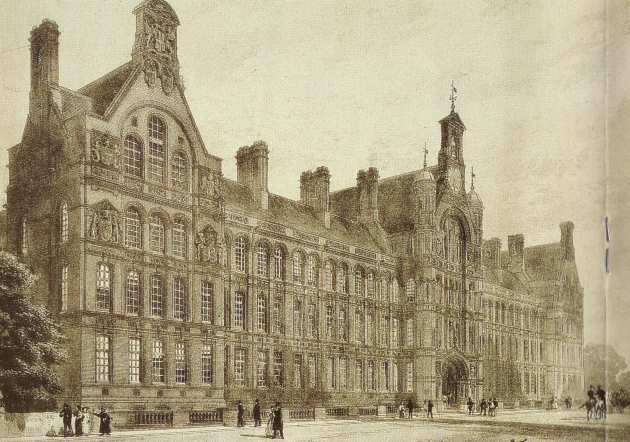 The Central Institution, later to become the City and Guilds College, was established by the City Livery Companies under the City and Guilds of London Institute. Unable to find a site in the City, they first set up the Finsbury Technical College. This was intended as a feeder school for the main College. As no other site became available in the City the CGLI were persuaded by General Sir John Donnelley, Secretary of the Science and Art Department, to build on land in South Kensington bought by the profits of the Great Exhibition of 1851 'for purposes of art and science' in perpetuity.
The Central Institution, later to become the City and Guilds College, was established by the City Livery Companies under the City and Guilds of London Institute. Unable to find a site in the City, they first set up the Finsbury Technical College. This was intended as a feeder school for the main College. As no other site became available in the City the CGLI were persuaded by General Sir John Donnelley, Secretary of the Science and Art Department, to build on land in South Kensington bought by the profits of the Great Exhibition of 1851 'for purposes of art and science' in perpetuity.
The Central Institution building was designed by Alfred Waterhouse, the architect responsible for the Natural History Museum. The City and Guilds Waterhouse building opened in 1884 and full time teaching began in 1885.
1893 - The Imperial Institute opened
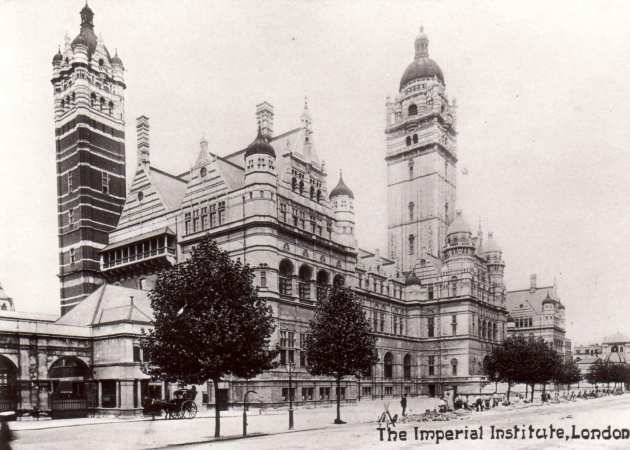 The Imperial Institute was created in 1887 to celebrate Queen Victoria's Jubilee with the intention of it being a scientific research institution exploring and developing the raw materials of the Empire countries. It was administered by a Governing body with the then Prince of Wales as President.
The Imperial Institute was created in 1887 to celebrate Queen Victoria's Jubilee with the intention of it being a scientific research institution exploring and developing the raw materials of the Empire countries. It was administered by a Governing body with the then Prince of Wales as President.
The Imperial Institute building was constructed in South Kensington between 1888 and 1893. Queen Victoria laid the foundation stone in 1888 and opened the building in 1893. The Institute building spanned from the Queen's Gate side, to where Mechanical Engineering now stands. It faced the Imperial College Road (which then was called the Imperial Institute Road and was open to traffic).
The Imperial Institute was designed by T. E. Collcutt in the neo-renaissance style. It was 700 feet long with a central tower (the Queen's Tower) and smaller towers at the east and west ends. It contained a library, laboratories, conference rooms and exhibition galleries with gardens at the rear.
1900 - Building work commences on the Royal College of Science
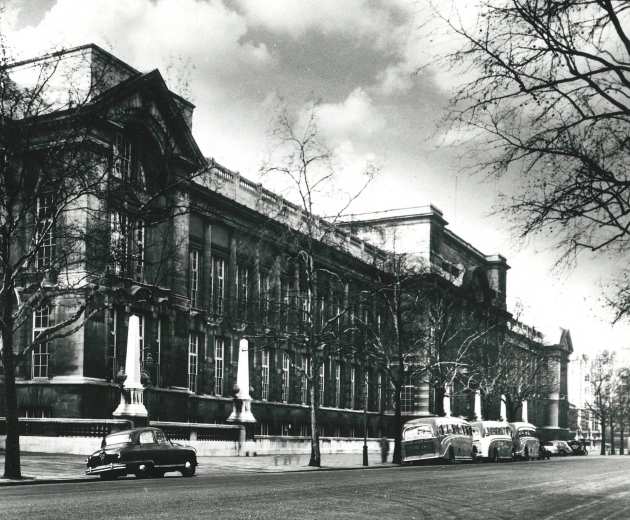 As the Royal School of Mines and Royal College of Science continued to develop, there were more than double the applications for student places than could be physically accommodated. A new building was needed especially for chemistry and physics, with large, modern, well equipped, laboratories.
As the Royal School of Mines and Royal College of Science continued to develop, there were more than double the applications for student places than could be physically accommodated. A new building was needed especially for chemistry and physics, with large, modern, well equipped, laboratories.
In 1898, the 1851 Commission offered the land opposite the Imperial Institute, valued at £100,000 if government funding was made available for construction of the building. The architect for the Royal College of Science building was Sir Aston Webb and was completed in 1906.
1906 - Board of Education Departmental Committee Report on the need for a higher technical education institution
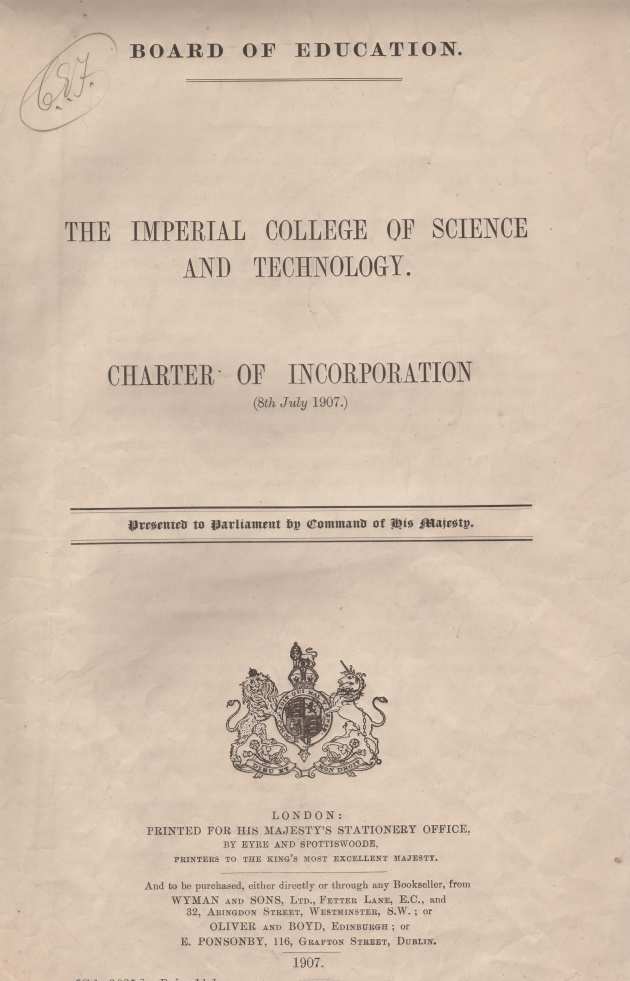 The Board of Education Committee report, in 1906, indicated that a high level scientific and technological educational institution should be established, combining Royal College of Science, the Royal School of Mines and the City & Guilds College.
The Board of Education Committee report, in 1906, indicated that a high level scientific and technological educational institution should be established, combining Royal College of Science, the Royal School of Mines and the City & Guilds College.
In educational and government circles, the debate about the need for a ‘London Charlottenberg’, a British higher technical education institution with applications to industry, had been continuing from the 19th century. The grouping of the RSM, RCS and C&G in South Kensington lent weight to the proponents’ arguments for such an institution.
In 1904 the Board of Education instituted a Departmental Committee to investigate the ‘present working of the RSM, RCS and C&G to see how they could best be utilised in the development of an integral higher technical and scientific institution. The Preliminary Report in February 1905 was positive about the integration into one body of the three institutions, but this required co-operation of the Board of Education and the government (for financial support) and the City and Guilds of London Institute. The private benefactors would contribute to building and equipment costs for the new institution.
In November 1905 the government funding was confirmed. The final Report of the Committee was published in January 1906, recommending combining the institutions into one. The 1851 Commissioners would make land available.
1907 - Signing of the Charter forming Imperial College
The final Report of the Board of Education Committee was published in January 1906, recommending combining the Royal College of Science, the Royal School of Mines and the City & Guilds College into one institution.
Negotiations on detail amongst the governing bodies of the institutions continued and in February 1907, the Board of Education issued a letter outlining its deliberations. On 26 March at the Old RSM old students dinner, the President of the Board of Education, Mr McKenna, read out some of a draft of the Charter of Imperial College. A list of members of the Governing Body was issued on 1 July and the charter forming Imperial College, was granted on 8 July.
1909 - Construction commences on Goldsmith's Extension and Royal School of Mines
In 1909, construction commenced on the Goldsmith's Extension and Royal School of Mines. It had become clear that the new institution, Imperial College, needed a new building to begin its expanded brief in. The 1851 Commission granted land, and an extension to the City and Guilds Building was funded by the Goldsmiths Company with the Royal School of Mines building being funded by benefactions from the Wernher, Beit and Company and the Bessemer Memorial Fund equipping the Metallurgy laboratories. The architect for the construction was Aston Webb.
Exactly two years after the creation of Imperial College, the foundation stone was laid on 8 July 1909 by Edward VII.
1910 - City & Guilds Delegacy
Incorporating the City & Guilds College into Imperial College involved altering the Charters of the City & Guilds of London Institute, the City & Guild College’s parent body and Imperial. The C&G Delegacy replaced the temporary committee of management set up by the City and Guilds of London Institute until satisfactory negotiations regarding control were completed.
The City & Guilds Delegacy was the outcome, comprising 19 members from the CGLI, the Goldsmith’s Company and Imperial’s Governing Body. It was responsible both to the CGLI and Imperial’s Governing Body for the administration of the C&GC. As all engineering subjects were deemed part of the C&GC, an Engineering Board was set up to advise Imperial’s Board of Studies.
Sir Walter Prideaux (1846-1928) Knight Clerk to the Goldsmith's Company, was one of the first members of the Governing Body and the Delegacy, serving 1907-1919.
1912 - Bessemer laboratory opens
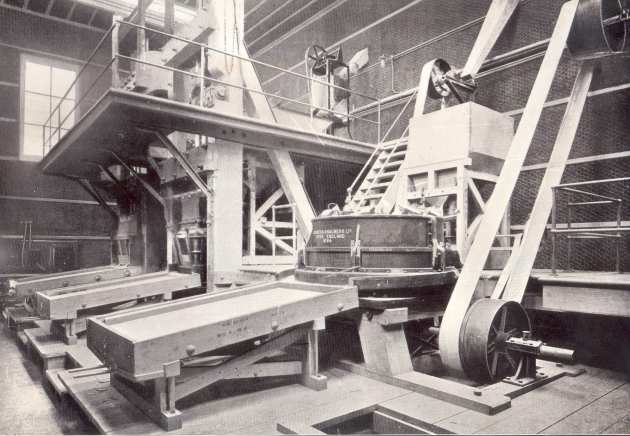 The Bessemer Laboratory for Metallurgy, funded by the Bessemer Memorial Fund, opened in 1912.
The Bessemer Laboratory for Metallurgy, funded by the Bessemer Memorial Fund, opened in 1912.
It was established at the same time as the drive for a College such as Imperial and so deemed an integral part of the new institution.
1913-14 - Beit Buildings completed
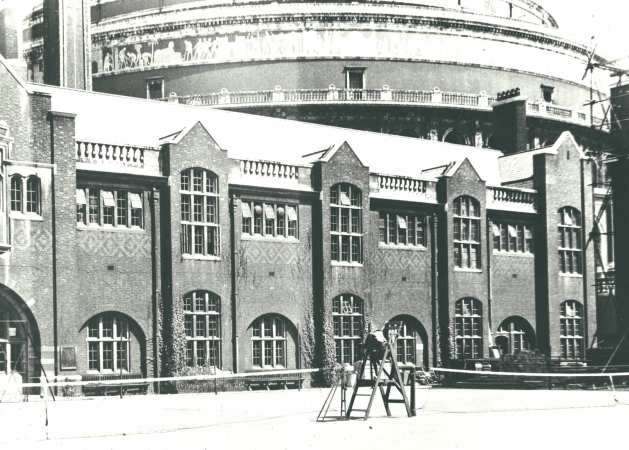 The original Students Union building in the north of the quad was designed by Sir Aston Webb and built in 1910-11. The idea for a building came from Sir Arthur Acland, a member of the governing body. He saw the need for a place in which students could meet and develop a collegiate social life. Sir Arthur 'emphasised the value in the life of students of a spirit of good comradeship, without which a student career was of little account'.
The original Students Union building in the north of the quad was designed by Sir Aston Webb and built in 1910-11. The idea for a building came from Sir Arthur Acland, a member of the governing body. He saw the need for a place in which students could meet and develop a collegiate social life. Sir Arthur 'emphasised the value in the life of students of a spirit of good comradeship, without which a student career was of little account'.
The east side was designed to house the departments of botany, plant pathology and physiology and was completed in 1914.
1914-18 - The College at war
By the outbreak of the First World War, there were approximately 900 students in college. Some 300 of them volunteered for war in 1914, joined by 60 staff members.
The South Kensington site was affected by the commencement of hostilities with buildings commandeered for war billeting of soldiers and military work. The War Office pay office took over the top two floors of Goldsmith's extension and RSM rooms and the Army Pay Corps Machine Gun section commandeered the RSM examination hall. Admiralty Inventions & Research Board took over the Engineering Structures lab & hydraulics lab in Goldsmith's.
The Admiralty commandeered the Physics workshop for bomb sighting research. The Air board (royal flying corps) took over the Huxley building drawing office and printing press. The Air Ministry also operated from the engine testing house resulting in complaints of noise from their neighbours.
Irish and Scots Guards Reservists also billeted soldiers in the RSM.
1914-18 - Scientific contribution to the war effort
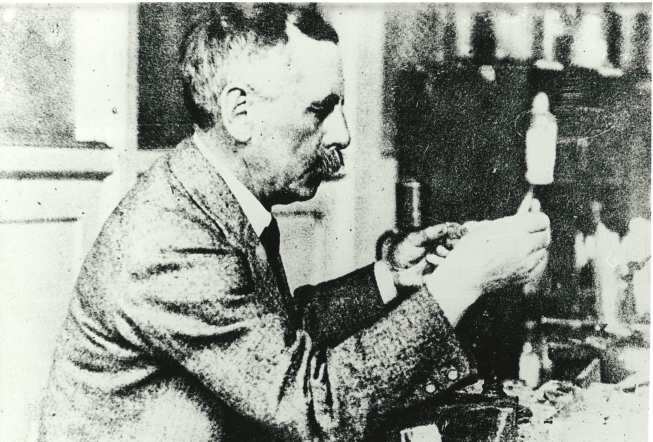
The College's most significant contribution to the First World War came from its inventions and scientific advances made throughout the war. Official badges were issued to those engaged in war work. Just a few examples follow:
- J.C. Philip oversaw production of drugs in academic institutions
- Jocelyn Thorpe set up a drug production line in the Chemistry department
- Trench warfare under the control of Martha Annie Whiteley who worked on lachrymatory gases; experimental trenches were constructed
- H. Brereton Baker worked on analysis of poison gases used by Germany, absorbants for gasses and a device for venting carbon monoxide after firing weapons in a pill box development and detection
- Hilda Judd and Dorothy Haynes of Botany worked on cold storage for foods
- Entomology Department worked on insecticides
- Aeronautical training was undertaken by Mechanical Engineering Professor W.E. Dalby
- Alfred Fowler, Professor of Astrophysics, worked on optics
- The Metallurgy Bessemer labs worked on Ministry of munitions work
- Mining Geology undertook oil testing for air ministry
- The physics department was involved in x-ray research, fuels and engines
- The Botany team worked on food science including large scale field experiments on wheat, cold storage, plant pathology and tropical hygiene
- The Biochemistry department investigated adhesives for aircraft
- The Entomology department worked on insecticides
- Engineering - Dalby - Admiralty Board of Inventions alternatives to steam engines in warships, diesel engines for submarines munitions manufacture
- J.T. Irwin from Electrical Engineering developed a giant parabolic reflector at Dover used as an early aircraft detection device
- Morley Davis from Geology created a one millionth map of Europe
- Percy Boswell worked on glass sands with the Ministry of Munitions
- Alumni also contributed to the war effort:
- William Sansome Tucker (RCS 1898-1902) as Major Tucker, was Director of Acoustical Research, Air Defence Experimental Establishment, Biggin Hill. He worked on artillery sound ranging in WW1 and afterwards continued government research on sound, that eventually led to the massive parabolic concrete sound mirrors still standing on the south coast, that would hopefully have detected the approach of enemy bombers. Construction was halted around 1937 when Wimperis set up the Tizard Committee on Radar.
- William Watson (1868-1919), RCS 1887-1890 and later Professor of Physics. He became Lieutenant Colonel and Director of Central Laboratory of Western Front and died from exposure to poisonous gas from the gas shells he examined.
1917 - Technical Optics Course established
The first technical optics course in the world was established in the Imperial Physics Department, developed partly in response to World War I and the need for the development of technical optics in the UK after reliance on German technology until the war.
1919 - Founding of Imperial College Boat Club
The Imperial College Boat Club was founded on 12 December 1919, with Charles Bristow beginning a life long association with the Club. The club developed from a union of the three constituent College boat clubs.
The Club's first win at the Henley Royal Regatta came in the 1923 Wyfold Challenge Cup.
1925 - Developments for the University of London BSc and the Imperial College Associateships
A difficulty for students in the 1920s at Imperial was that some of the courses for which they would receive an Associateship from RSM, RCS and C&G were not taught elsewhere in London University and could not count towards the BSc that students had to take besides the Associateship or DIC (Diploma of Membership) of Imperial College.
These included Aerodynamics and Aeronautical Engineering, Astrophysics, Biochemistry, Chemical Technology and Fuel and other specialised branches of Engineering, Entomology, Meteorology, Mining Geology, Oil Technology, Optical Engineering and Technical Optics and Plant Physiology. The outcome in 1925 was that London University agreed to set final examinations in the subjects in which Imperial set its Associateships.
1926 - The first student hostel was opened in Beit Quadrangle
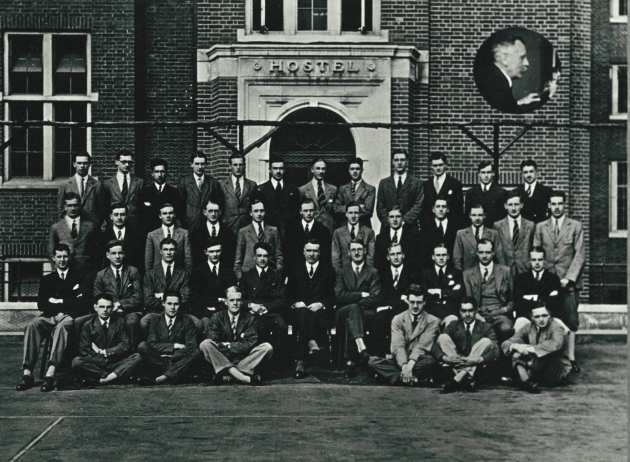 The original Students Union building in the north of the quadrangle was designed by Sir Aston Webb and built in 1910-1911.
The original Students Union building in the north of the quadrangle was designed by Sir Aston Webb and built in 1910-1911.
Student accommodation was needed as an addition to the social life of Imperial and so plans for a student hostel were drawn up. The UGC gave a substantial sum, supplemented by personal generosity of governors and some City Livery Companies.
In April 1926, the hostel opened with accommodation for 49 students and a warden. During the 1926-1927 session the Hostel places were taken by 20 C&G students, 15 RSM students and 14 RCS students.
Living in hall as opposed to living in digs had such an appeal that a waiting list for places swiftly developed. Seeing this as an opportunity to improve facilities for the Union and Botany, the Governing Body launched an Extension Scheme, and a Fund set up for donations. The extension plan was for two new storeys to the Union building, one storey to accommodate 27 more hostel bed-sitting rooms with a wardens flat, the top storey to contain modern kitchen and dining facilites for 400, thus freeing the current dining space for social purposes.
An article in Phoenix on the twenty-first anniversary of the union describes the accommodation, and notes that there was a reading room for women students as they were excluded from the bar.
1928 - First film footage
The first recorded film footage of activities at Imperial College London was made at Morphy Day in 1928. Watch the recording here, including film of rowing at Putney and Sports Day at Chelsea Football ground.
1933 - Boanerges becomes the official mascot of the City & Guilds College Union after being bought for £40 in 1933
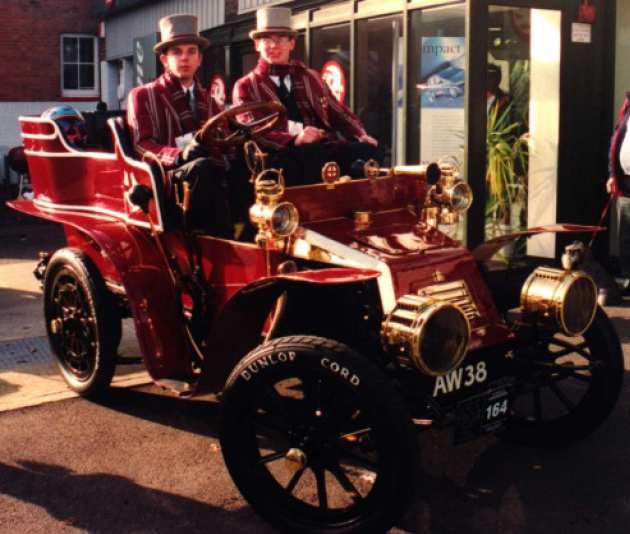 Boanerges, or Bo’, is the official mascot of the City & Guilds College Union and is run by the City & Guilds Motor Club. The present Bo’ has been owned by the City and Guilds College since 1933 and has been maintained by students ever since.
Boanerges, or Bo’, is the official mascot of the City & Guilds College Union and is run by the City & Guilds Motor Club. The present Bo’ has been owned by the City and Guilds College since 1933 and has been maintained by students ever since.
The first Boanerges was a 1908 Rover which took part in several Brighton runs during the 1920s. However, the organisers began to realise that he shouldn't really take part because he was too young and he no longer became eligible for the run. The story of the first Boanerges' disposal is an amusing anecdote in the history of the college. He was driven to Downing Street (Ramsay Macdonald was Prime Minister), the gearboxes were promptly filled with gravel, and a well dressed dummy with a biscuit in his hand was left in the passenger seat. This was a protest against the recent knighthood of the chairman of a leading biscuit manufacturer. Apparently, the police had considerable difficulty in moving the car and so the Guilds students had proved their point.
The first Boanerges was never seen again although it was becoming uneconomical to keep the car running and in a satisfactory condition. After this event, a search was begun for a pre-1904 veteran which would be eligible for future Brighton runs. 3 enterprising Guilds students found a suitable car and the current Bo' was purchased for £40 in 1933.
Since coming to the College, Bo’ has taken part in nearly every Brighton run for the last 65 years, and finished most of them.
- Listen to a description of Bo recorded in 1957.
- Read more about Bo and shared your memories of the C&G mascot
1934 - Hilary Bauerman Bequest
A student in Metallurgy at RSM 1851-1853, and close associate of College throughout his career, even though much of it was spent abroad, Bauerman left a bequest to enable students to travel after graduation.
1938 - Opening of the Boat House at Putney
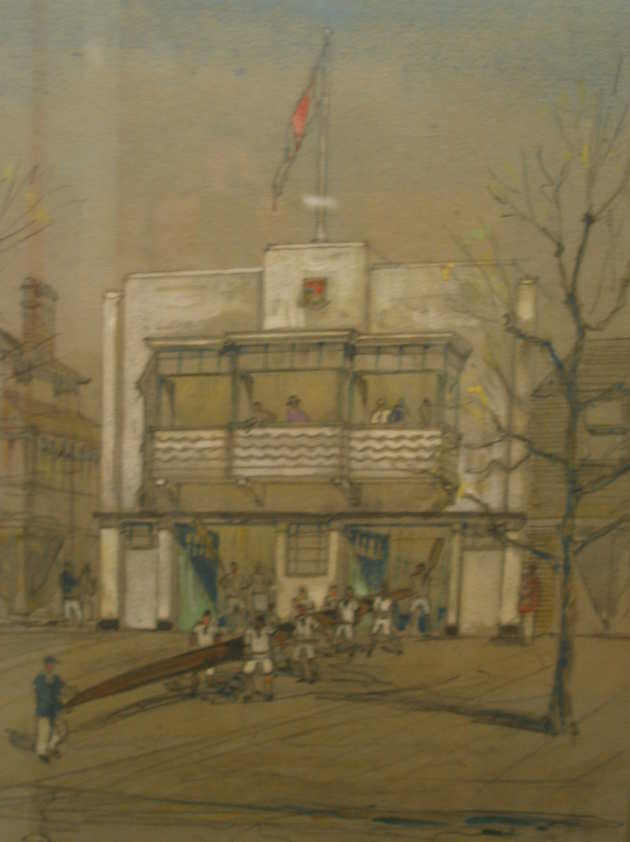 The new Boathouse at Putney was opened by Lord Desborough, on 21 October 1938, designed and built by Charles Bristow.
The new Boathouse at Putney was opened by Lord Desborough, on 21 October 1938, designed and built by Charles Bristow.
The commemorative plaque from the occasion reads, "May all who use this boathouse in it find such happiness and make such friendships as may endure throughout their lives.
1939 - The outbreak of war
Following the declaration of war, it was decided not to take in new students to the College. However this decision was rescinded on 17th October 1939 and College re-opened. Some courses were evacuated - Metallurgy, Metallurgy Department teaching for 3rd and 4th year students transferred to Swansea but the South Kensington Department remained open to provide instruction for students of others departments, conducted by Dr. S. W. Smith. 1st and 2nd year metallurgy students remained in South Kensington.
The Miners moved to Cambourne and the Biologists to their field station at Slough.
As with the First World War, many buildings were commandeered by the government and military including the Huxley Building, Henry Cole Wing, Beit, RSM and Boathouse.
1941 - College life during the war
As students were unable to train with the University of London Officer Training Corps because of the Second World War, the Rector, Sir Henry Tizard (1885-1959) invited Major W.H. Bevan to address the students with the idea of them forming a Home Guard Platoon. "C" Company, 2 London, Home Guard, Imperial's own company, formed in September 1941, with the addition of some Royal College of Music volunteers later that year.
At first it was a student Home Guard Platoon, but in 1942 was joined by staff members from Imperial College Maintenance Party, the College war emergency group. C Company was responsible for an area including Kensington Gardens, Knightsbridge, Queen's Gate, Fulham Road and Old Brompton Road to Drayton Gardens. In all, 250 Imperial College students passed through the Company.
Major Bevan showed his high regard for the Company by obtaining special official appreciation from the military authorities in the form of two presentations to individuals of a Certificate of Good Conduct and Commendation. The Company was at "Stand Down" from 1944.
On 13th and 14th May 1944 some members of C Company, including Charles Benjamin Alcock, a Chemistry Undergraduate (1942-1944), shown in the picture, were part of the King's Guard at Buckingham Place.
An Imperial College Maintenance Party and Air Raid Precaution (ARP) centre was set up and housed in the RSM building with W. R Jones in charge. Many staff volunteered for night watching and weekend duties.
The Imperial College Administration and Maintenance Party was formed to undertake fire watching and other Air Raid Precautions. ARP duties were extremely important for the protection of College buildings and personnel. Dr H.J.T. Ellingham, Chemistry, played a leading part in A.R.P. activities, including the leisure aspects.
Profs. Read and Sweeting volunteered for the permanent squad and for most of the 1940-41 session lived in the basement of the Mines Building, alongside Dr. Davies, W. S. Tweed and Faulkner of the Mining Department. They cooked and cleaned for themselves, sleeping in camp-beds (christened by Read as the "Ghetto"). The Fire Captain was the Head Cleaner of the R.S.M., Bill Guiver.
Special regulations related to enemy air raids were applied during College hours. A loud bell warned of 'approaching raiders', often followed by another denoting 'raiders overhead'. Staff and students were instructed to leave their rooms and make for the basement. Early in the war this descent occurred about once a day but later in 1943/44 it frequently happened three times daily.
There were two direct hits by enemy bombs on College buildings, but no-one was injured. One bomb exploded at the rear of the RSM and one fell on the City and Guilds Waterhouse building, but did not explode.
Parts of the Beit Building were taken over to house military personnel early in the war, and returned to College in 1942. College was able to claim for damage caused during the requisition period, as were all owners of similarly requisitioned buildings.
But besides study and Home Guard/ARP duties, not to mention the problems of rationing and public transport, students carried on with activities such as amateur dramatics and sports. The Radio Society was shut down at the start of the war for fear of a breach of security.
1944 - Alumni and the Second World War
Below are just a few of the many alumni who contributed to the war effort:
Sir Frederick Handley-Page (1885-1962) City and Guilds (Finsbury Technical College 1901-03), founded Britain's first aircraft manufacturing company in 1909. During World War II his company produced heavy bombers, including the Halifax.
Alan Dower Blumlein (Electrical Engineering 1903-1942) City and Guilds 1921-23 worked for EMI on a radar system, and adapted some of his previous work on circuit design technology for use in television to a 60 MHz pulsed radar. Accuracy of navigation was very important to the accuracy of bombing and it was to increase navigation accuracy that the H2S ground mapping radar was designed. Blumlein researched one format using the klystron as a transmitter, but development of this was slow, and the Telecommunications Research Establishment with GEC was speedily developing a system using the magnetron. It was during a test flight demonstrating the TRE/GEC model that Blumlein died as faulty maintenance of the Halifax caused it to crash.
Bruce White (Electrical Engineering 1902-05) directed the work on the Mulberry Harbours, the sheltered harbour structures used to land equipment and supplies in readiness for the Allies D-Day landings for the War Office. Advice was taken from staff in the Civil Engineering Department.
A.C. Hartley (Civil and Mechanical 1908-10) worked on implementing the system for Fog Dispersal (FIDO - Fog Investigation and Dispersal) on selected airfields for the Petroleum Warfare Department. His co-workers included E. G. Walker (Civil and Mechanical 1902-04) and D.A. Fox (Civil 1933). The Chief Engineer for the contractors was W.H.G. Roach (Civil 1919-21).
Colonel Bill Hudson worked for the Special Operations Executive Section D "ungentlemanly" warfare section, and Mrs Yvonne Cormeau, who worked for the College Archives in the 1960s, was a member of the French Resistance, her code name being "Annette".
1945 - Visit of King & Queen that Commemoration Day is named after (October 1945)
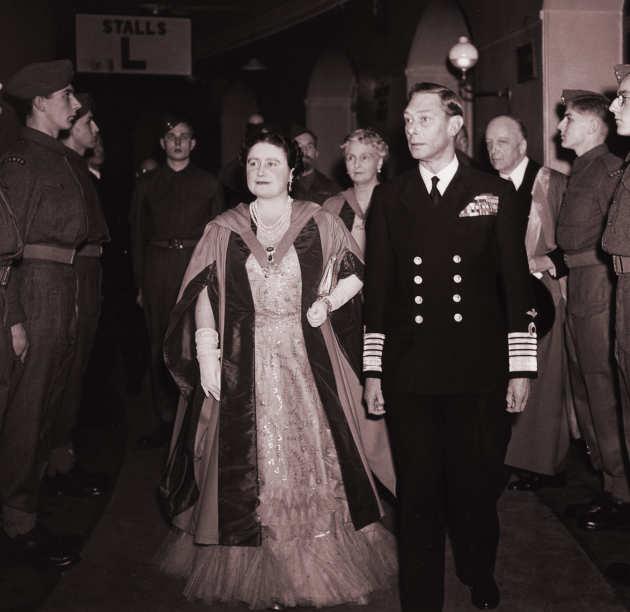 King George VI and Queen Elizabeth in 1945 visited College to commemorate centenary of Royal College of Science, oldest forerunner to Imperial.
King George VI and Queen Elizabeth in 1945 visited College to commemorate centenary of Royal College of Science, oldest forerunner to Imperial.
King George said: "You students here assembled - men and women who soon will be going out from the Imperial College to your work in the world - have not only an opportunity but also a responsibility greater than men of science have known before. To you, I say: Regard your knowledge and your skill always in the light of a trust for the benefit of humanity, and thereby ensure, so far as in you lies, that science may never be put to uses which offend the higher conscience of mankind."
1947 - Acquisition of Silwood Park Campus
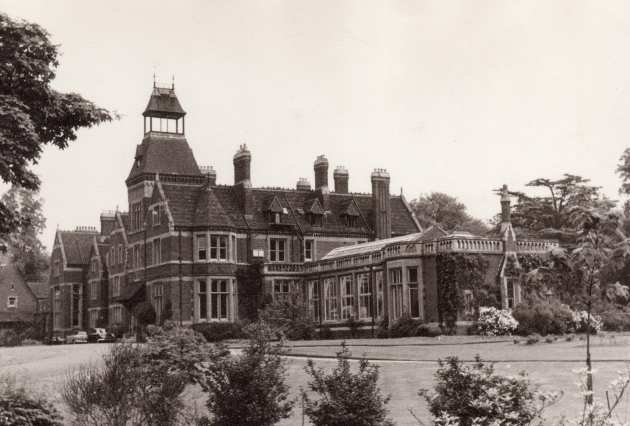 Imperial College acquired Silwood Park in 1947, as a Field Station to provide a site for research and teaching in those aspects of Biology not well suited for the main London campus. Instrumental in this was Munroe.
Imperial College acquired Silwood Park in 1947, as a Field Station to provide a site for research and teaching in those aspects of Biology not well suited for the main London campus. Instrumental in this was Munroe.
Watch a documentary made about Silwood Park in 1982.
1949 - Felix - student newspaper - launched 9 December 1949
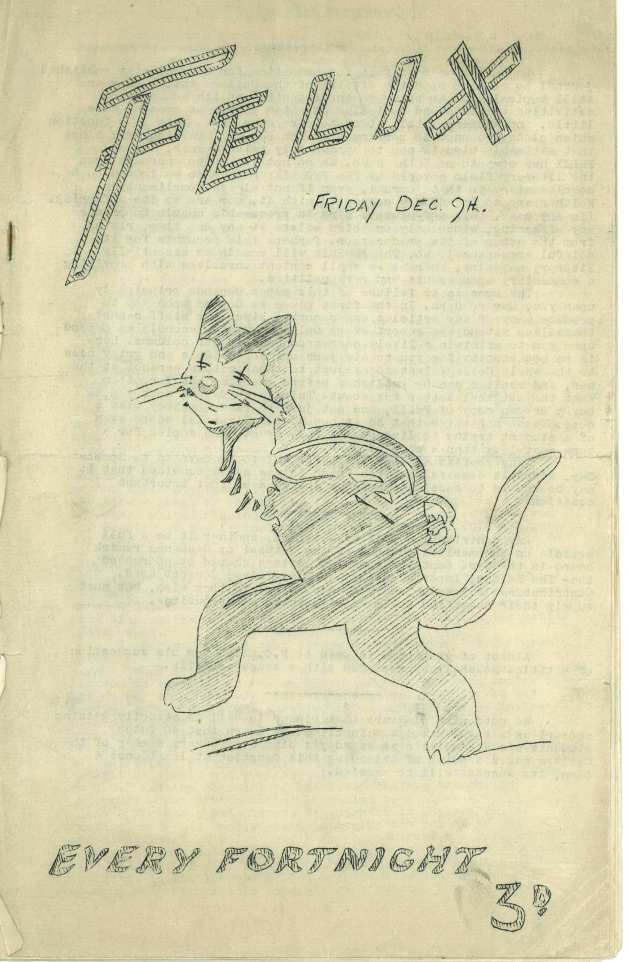 Felix, Imperial's student newspaper, was launched on 9 December 1949.
Felix, Imperial's student newspaper, was launched on 9 December 1949.
1950 - Inception of expansion scheme was 29th January 1950
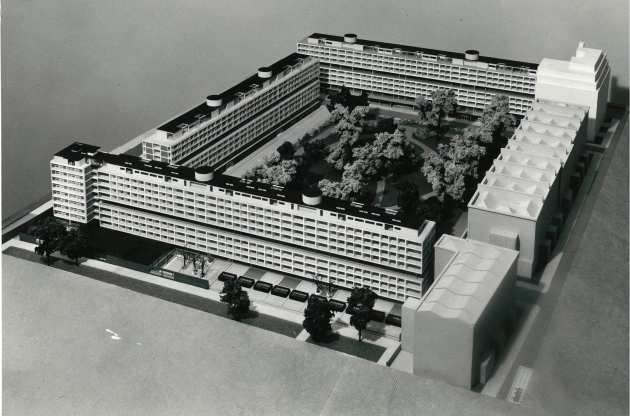 On 29th January 1950, the government announced in the Commons that it was intended that imperial College should expand to meet the scientific and technological challenges of the 20th century. As a result, the Rector, Sir Roderic Hill, launched the Jubilee Expansion Scheme. Development officers were appointed, who investigated similar overseas and UK institutions. The expansion had to include both technology and science; plans for innovations such as computing were made, General Studies, Management Studies and History for Science and technology were all new subjects to be added to the curriculum. New buildings included a large library and a 1000-seat Great Hall.
On 29th January 1950, the government announced in the Commons that it was intended that imperial College should expand to meet the scientific and technological challenges of the 20th century. As a result, the Rector, Sir Roderic Hill, launched the Jubilee Expansion Scheme. Development officers were appointed, who investigated similar overseas and UK institutions. The expansion had to include both technology and science; plans for innovations such as computing were made, General Studies, Management Studies and History for Science and technology were all new subjects to be added to the curriculum. New buildings included a large library and a 1000-seat Great Hall.
Between 1953 and 1963, the government required Imperial College to double in size. Student numbers had to be increased to 3,000 during the quinquennium 1957-1962. The Rectors in office during this period, both Sir Roderick Hill until 1954 and between 1954 to his untimely death in 1966, Sir Patrick Linstead enthusiastically took up the challenge.
1953 - Private visit to Imperial by Duke of Edinburgh
Shortly before the coronation of Queen Elizabeth II May 10th Prince Philip visited College privately. Prince Philip has a strong interest in Science and Technology and its application to industry.
1955 - Jez is donated to the Royal College of Science Motor Club as its mascot
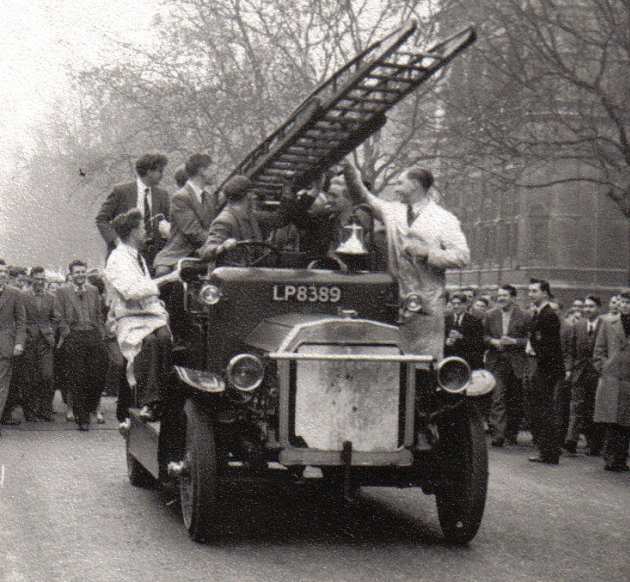 In 1955 the students of the Royal College of Science were looking for a suitable means of transport for their President. On finding that there was a fire engine for sale, the students made an offer of £50 for the vehicle, but the owners, Joseph Crosfield and Son, decided to donate it to the students for its "educational value".
In 1955 the students of the Royal College of Science were looking for a suitable means of transport for their President. On finding that there was a fire engine for sale, the students made an offer of £50 for the vehicle, but the owners, Joseph Crosfield and Son, decided to donate it to the students for its "educational value".
They travelled to Warrington to collect it, with their only introduction being a drive round the block, after which they faced a two hundred mile journey with considerable trepidation. The reliability of the fire engine was in serious doubt, and the problems attached to restarting the engine if it stalled, or indeed was deliberately stopped, appeared to be rather overwhelming. The average range for a man when operating the starting handle had been quoted as 25 feet. The brave four set out, and were soon tearing along, but the driver at the time claimed he was not quite sure whether he, or the fire engine, was in control at the time. The name "Jezebel" was eventually chosen due to the vehicle's temperament, which can be summed up by the following quote from a driver at Crosfield's: "when not trying to turn around in a circle, Jezebel had a pronounced tendency to proceed sideways like a crab".
Read more about Jez and share your memories of the RCS mascot.
1957 - The Roderic Hill building opened by Queen Elizabeth The Queen Mother
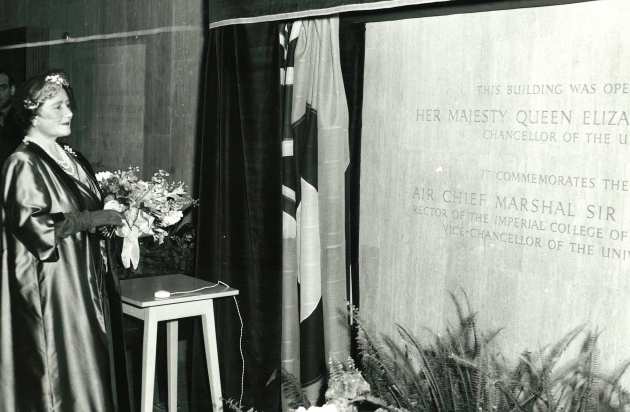 A new building for Aeronautics and Chemical Engineering, named after Sir Roderic Hill, Rector 1948-1954 was opened by Queen Elizabeth the Queen Mother in 1957.
A new building for Aeronautics and Chemical Engineering, named after Sir Roderic Hill, Rector 1948-1954 was opened by Queen Elizabeth the Queen Mother in 1957.
1957 - College's 50th anniversary
1957, the 50th anniversary year, saw College far into a great building project to accommodate the modern teaching and research facilities and students that would fulfil the vision for expansion in scientific and technological education. By 1957, the floor space had been increased by 20%.
Estimates for the building work in December 1957 were: 85,000 cubic yards of cement, 3,250 tons of steel reinforcements and 6 million bricks! It was not all plain sailing though as disputes could not be settled as easily as Professor Blackett envisaged by imposing academic solutions.
Also in 1957, work began on the Mechanical Engineering Building, which was being constructed behind the Waterhouse designed City and Guilds Building.
Other 50th birthday celebrations included a 50th birthday dinner held at Mansion House, a ceremony in the new Union Concert Hall and a College Ball.
Listen to a special 50th birthday radio broadcast about Imperial
1957 - Exploration Board established
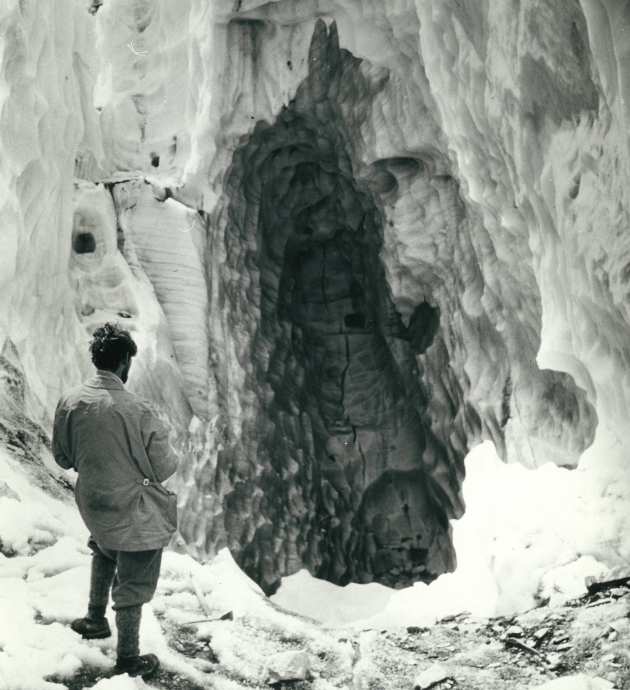 Imperial's Exploration Board set up to assist students who wish to travel and work on projects, with the first trip to Karakorum.
Imperial's Exploration Board set up to assist students who wish to travel and work on projects, with the first trip to Karakorum.
Read about today's expeditions.
1959 - Biochemistry Department
In 1959 the Wolfson Foundation gave £350,000 for a new Biochemistry Department, with Sir Ernst Chain as its first Professor.
1959 - Weeks Hall is completed and opened
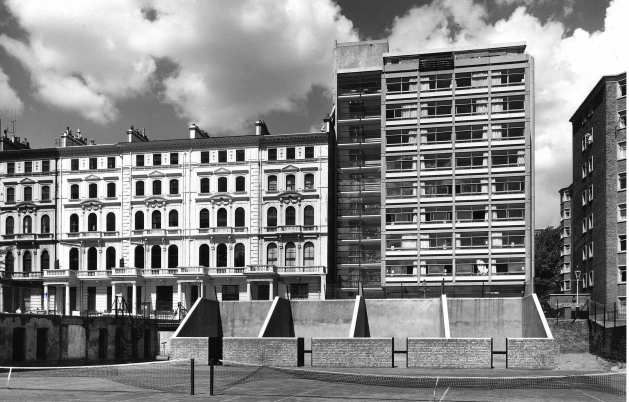 An increase in halls of residence capacity was a necessity and the opportunity to expand residences in Princes Gardens, the square across Exhibition Road, was enthusiastically developed with Sheppard Robson as architects.
An increase in halls of residence capacity was a necessity and the opportunity to expand residences in Princes Gardens, the square across Exhibition Road, was enthusiastically developed with Sheppard Robson as architects.
Weeks Hall was begun in 1957 due to the generosity of a donation from Vickers the engineering company which benefited from Imperial trained students. Lord Weeks was the Chairman of Vickers Ltd 1945 - 1956 and was instrumental in obtaining funding for the Hall, which was to include a summer conference centre for Vickers.
1960 - Clem joins the Royal School of Mines as its motorised mascot
Clementine II (Clem) is the Royal School of Mines motorised mascot. She is a 1926 Morris T-type (tonner) truck and was bought by the RSMU in 1960 as a replacement for their previous mascot, Clementine I - a five ton Aveling and Porter steam traction engine.
1963 - Special Relationship with the Indian Institute of Technology (Delhi)
The special relationship with the Indian Institute of Technology (Delhi) was launched in 1963. It was to include long term secondments of Imperial staff, the training of Indian staff and short visits to Delhi by senior Imperial staff. Professor Sir Willis Jackson headed the Imperial initiative and chaired the group involved. Professor N. P. W. Moore of Mechanical Engineering was the first seconded member of Imperial staff to visit Delhi.
1963 - Department of History of Science and technology opened
The teaching of the history of science and technology at Imperial began in 1963, with the first Professor A. Rupert Hall. The department was based in Queen's Gate and taught postgraduate students.
1963 - Princes Margaret opens Southside, Electrical Engineering and Civil Engineering buildings
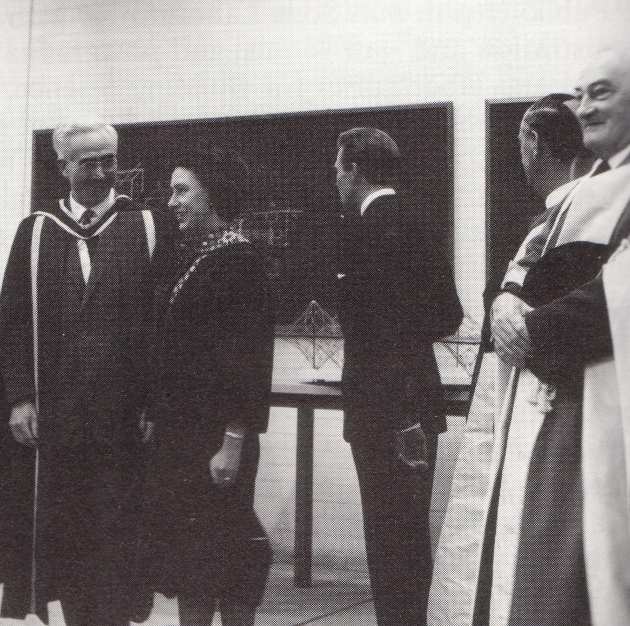 HRH Princess Margaret opened Southside Halls of Residence on 8th October. This increased student accommodation so that 20% could live in halls, compared to 8% in 1955.
HRH Princess Margaret opened Southside Halls of Residence on 8th October. This increased student accommodation so that 20% could live in halls, compared to 8% in 1955.
After she had opened Southside, she visited two other new buildings at South Kensington. In Electrical Engineering, she was given a demonstration of bandwidth compression and in Civil Engineering she viewed a model dam.
Listen to Sir Patrick Linstead’s speech from the official opening ceremony of Southside in 1963.
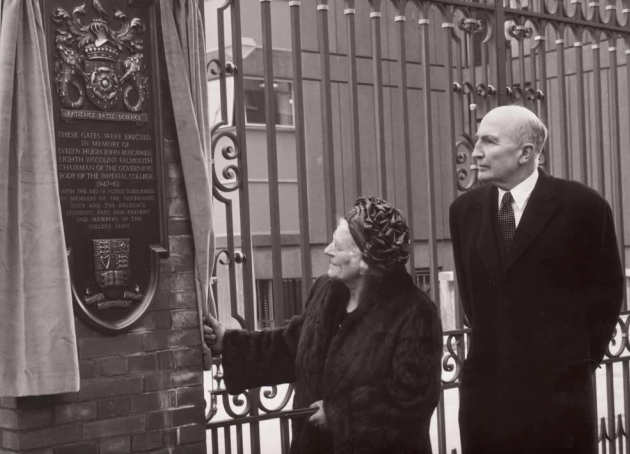
1963 - Falmouth Gates given as memorial to Lord Falmouth
The Falmouth Gates were designed as a memorial to Viscount Falmouth, Chairman of the Governing Body 1947-1962 and placed at the East entrance to Imperial by 170 Queen's Gate. They were inaugurated by Lady Falmouth.
1965 - Biochemistry Building opened
On Thursday 4th November 1965, Her Majesty Queen Elizabeth the Queen Mother, Chancellor of London University opened the new Biochemistry Building. She unveiled a commemorative plaque and was presented with a bouquet by Judith and Daniel Chain, the 8 year old twins of Professor Ernst and Mrs Anne Chain, Professor Chain being head of the Biochemistry Department. Listen to the opening ceremony.
1965 - Nuclear Reactor opened
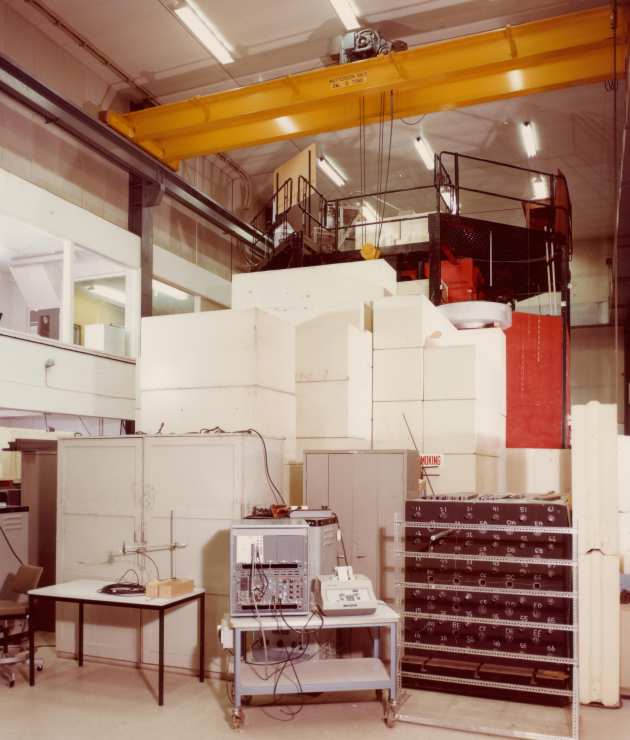 An increasing demand for research and training facilities in nuclear science led in 1961 to a Government announcement of a national programme for the provision of low-power nuclear reactors to be available to universities and colleges of technology. Three reactors were approved in principle, one to serve the needs of the South of England. The University of London subsequently decided that this reactor should be located at the Imperial College Field Station at Silwood Park where the College would be responsible on behalf of the University for its management.
An increasing demand for research and training facilities in nuclear science led in 1961 to a Government announcement of a national programme for the provision of low-power nuclear reactors to be available to universities and colleges of technology. Three reactors were approved in principle, one to serve the needs of the South of England. The University of London subsequently decided that this reactor should be located at the Imperial College Field Station at Silwood Park where the College would be responsible on behalf of the University for its management.
The project was financed for an initial period of five years from 1962 by a grant from the Science Research Council and subsequently supported by the University with funds from the University Grants Committee. The 100 kW 'Consort' Reactor Mark II, which was designed jointly by the Nuclear Power Group of the Mechanical Engineering Department at Imperial College and by the General Electric Company Limited, commenced operation in April 1965. A new building adjoining the reactor hall was completed in 1971 and provides radiochemistry and physics laboratories, workshops and office and study accommodation.
1966 - Physiological Flow Studies Unit opened
Founding staff of the Physiological Flow Studies Unit included Professor Colin Caro and Bob Schroter. The creation of the unit was instigated by joint research between Colin Caro a physician and James Lighthill, an applied mathematician and fluid dynamist. They applied medical and engineering knowledge to study of blood and body fluid circulation and respiration.
1968 - Opening of Linstead Hall
Construction was funded by an anonymous benefactor in 1963 who stipulated that dining facilities must be available for male residents. Originally known as New Hall, it was named Linstead Hall after Sir Patrick Linstead, who died prematurely in 1966. Sir Patrick was the Rector responsible for obtaining the land on Princes’s Gardens for student accommodation. It was his vision that every student should have the opportunity of spending a year in a hall of residence.
1969 - College appeal launched to raise 2 million for costs towards student accommodation
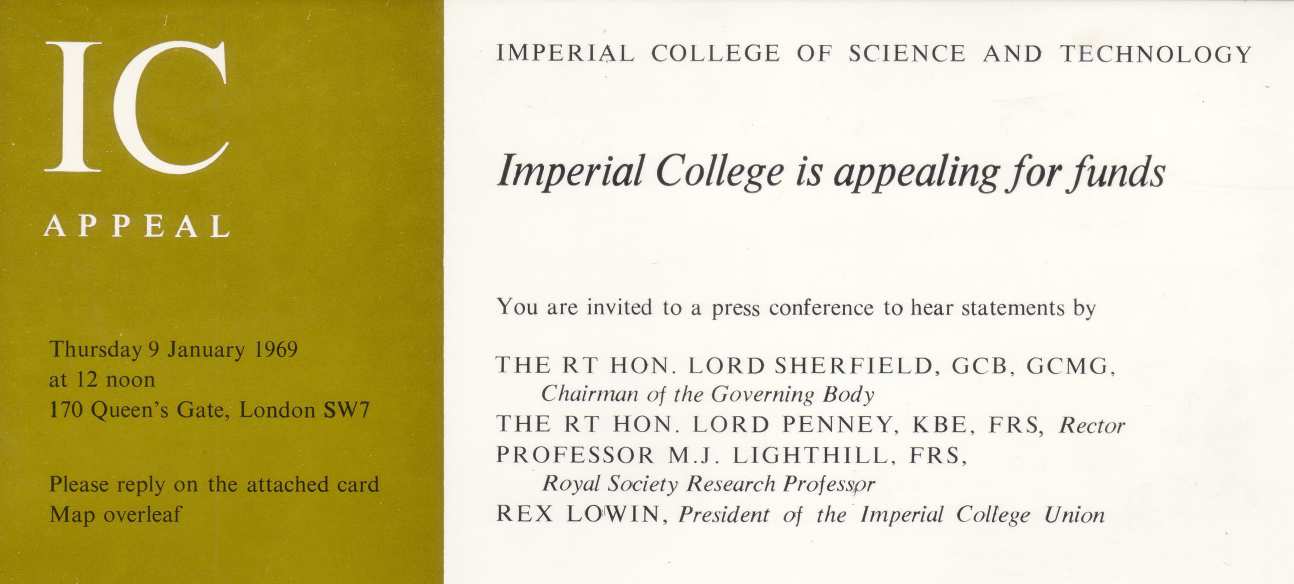 An appeal for £2million for student and staff accommodation and for academic and general purposes was launched in 1969:
An appeal for £2million for student and staff accommodation and for academic and general purposes was launched in 1969:
- £1.1 million for residential building and conversion
- £200,000 for the development of Silwood park, for laboratory blocks and student accommodation
- £700,000 for academic and general purposes as Imperial almost completely lacked endowment.
Speakers at the appeal launch were Lord Sherfield, Chairman of the Governing Body; Lord Penney, Rector; Professor M.J.Lighthill, Royal Society Research Fellow at Imperial and Rex Lowin, the President of the Imperial College Students Union.
1969 - Demolition of the Imperial Institute and completion of Queen's Tower as free standing campanile
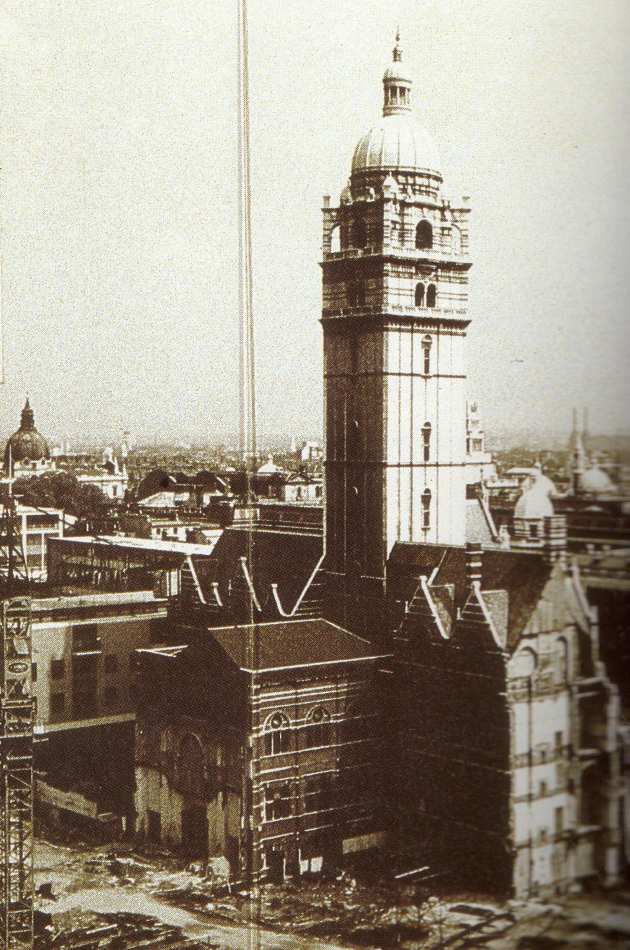 Following the move of the Imperial Institute to the Commonwealth Institute, it became clear that the Institute building was no longer suitable for its original purpose of being a "scientific research institution exploring and developing the raw materials of the Empire countries". It was not adaptable to the College requirements for mid 20th century science and technology. It was agreed that the building should be demolished to enable the expansion of Imperial College and the building of modern laboratories, under the auspices of the governments plan for development of science and technology in higher education.
Following the move of the Imperial Institute to the Commonwealth Institute, it became clear that the Institute building was no longer suitable for its original purpose of being a "scientific research institution exploring and developing the raw materials of the Empire countries". It was not adaptable to the College requirements for mid 20th century science and technology. It was agreed that the building should be demolished to enable the expansion of Imperial College and the building of modern laboratories, under the auspices of the governments plan for development of science and technology in higher education.
Plans for this were well developed when a campaign against the demolition developed, led by the Poet Laureate and great supporter of Victoriana, John Betjeman. Press articles appeared and as the pressure mounted, parties on both sides had their say. As Lord Home stated - "many will regret this change in the Kensington landscape. But it is symbolic of the needs of the times that we can no longer rest on the memorials of past greatness but must prepare for a new but different greatness of the future." Julian Huxley suggested in a letter to the Times that the situation be resolved by retaining the Collcutt Tower (now the Queen's Tower) as a free standing campanile. This compromise was accepted, though it took another ten years for this work to be completed, with the planning being undertaken by the Civil Engineering Department.
During demolition, a casket was found under the foundation stone, the Bhownagree casket. This contained a lock of hair of Awabia Merwanje Bhownagree, the sister of Sir Mancherjee Merwanjee Bhownagree. Mr Bhownagree funded the colonnade which connected the Jehangir Hall with the Indian Gallery.
1969 - Opening of the College Block (Sherfield Building) and Library
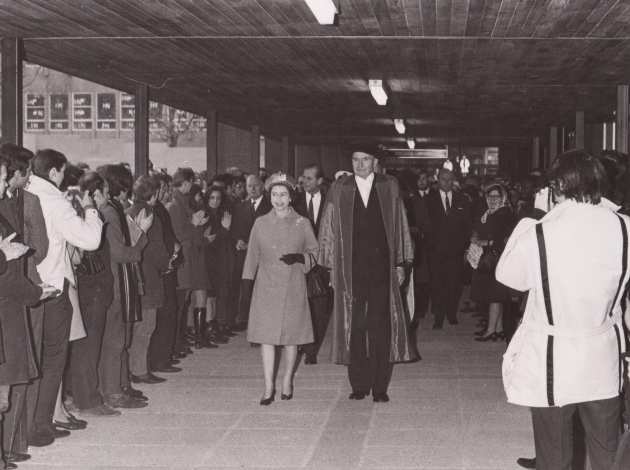 The College Block, including the Administration and Library Buildings, was initially known was opened by her Majesty the Queen, in November 1969.
The College Block, including the Administration and Library Buildings, was initially known was opened by her Majesty the Queen, in November 1969.
1971 - Department of Metallurgy changes name to include Materials Science
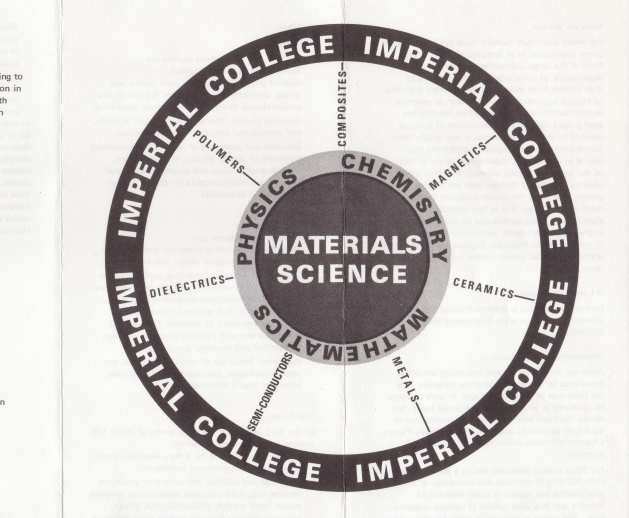 Two separate degree courses are established: Metallurgy, leading to a BScEng. degree and Materials Science, leading to a BSc.
Two separate degree courses are established: Metallurgy, leading to a BScEng. degree and Materials Science, leading to a BSc.
A high voltage transmission electron microscope is obtained and research continues to thrive both in metallurgy and in ceramic, electrical and composite materials.
1971 - Department of Management Science created
The Management Engineering Section of the Mechanical Engineering Department became an independent department of Management Science with Samual Eilon as Head of Department and Professor of Management Science.
1972 - Associated Studies Department created
Members of the new department included Sinclair Goodlad who taught expression of technical ideas to students in the Electrical Engineering Department. The development of foreign language teaching was an important element.
1976 - Physics Building renamed Blackett Laboratory
Prime Minister Harold Wilson gave the Blackett Memorial Lecture and renamed Physics Building the Blackett Laboratory.
1976 - Pimlico Connection launched
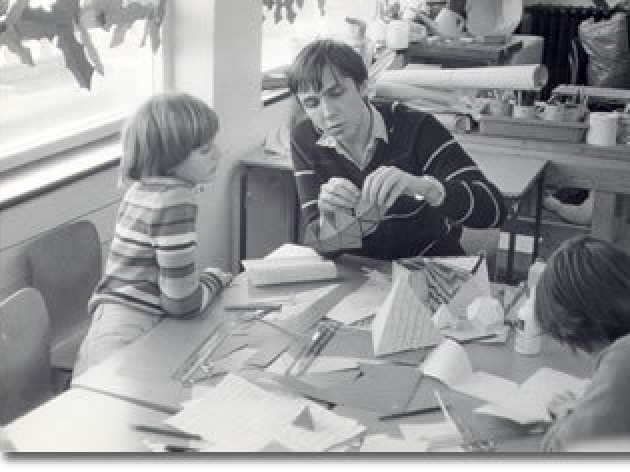 The Pimlico Connection was launched as a scheme for Imperial engineering students to assist with science teaching in local schools. The initiative was instigated by Sinclair Goodlad, Electrical Engineering and the Humanities Department.
The Pimlico Connection was launched as a scheme for Imperial engineering students to assist with science teaching in local schools. The initiative was instigated by Sinclair Goodlad, Electrical Engineering and the Humanities Department.
- Watch footage of the Pimlico Connection's 30th birthday party.
- Read about the Pimlico Connection today
1976 - Anonymous benefaction for student hall residence which became Linstead Hall Extension
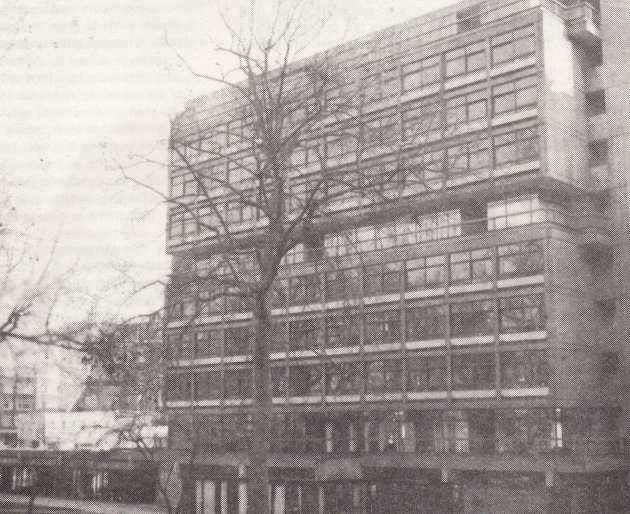 A further benefaction for an extension of a student hall of residence was received in 1976, on the understanding that the donor remain anonymous, and dining facilities continued to be provided and that women could now be admitted. As a result, Linstead Hall Extension was built on east side Princes’ Gardens.
A further benefaction for an extension of a student hall of residence was received in 1976, on the understanding that the donor remain anonymous, and dining facilities continued to be provided and that women could now be admitted. As a result, Linstead Hall Extension was built on east side Princes’ Gardens.
1977 - Huxley Building on Queen's gate completed
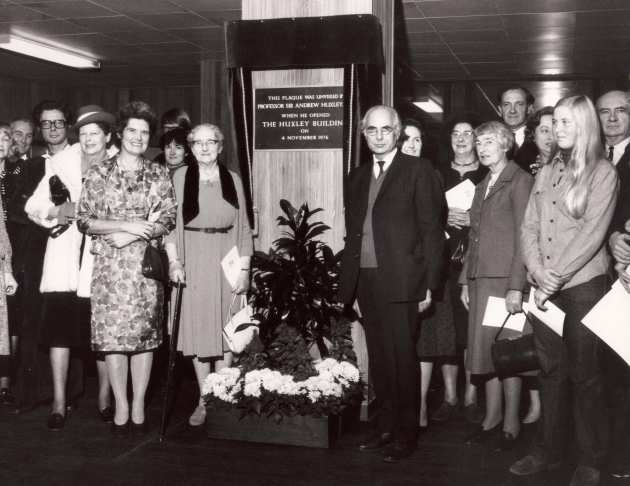 The Huxley Building on Queen's Gate accommodated the Department of Computing and the Department of Mathematics.
The Huxley Building on Queen's Gate accommodated the Department of Computing and the Department of Mathematics.
It was opened by Sir Andrew Huxley, the grandson of T.H. Huxley, the first Dean of the Royal College of Science.
1978 - Department of Social And Economic Studies founded
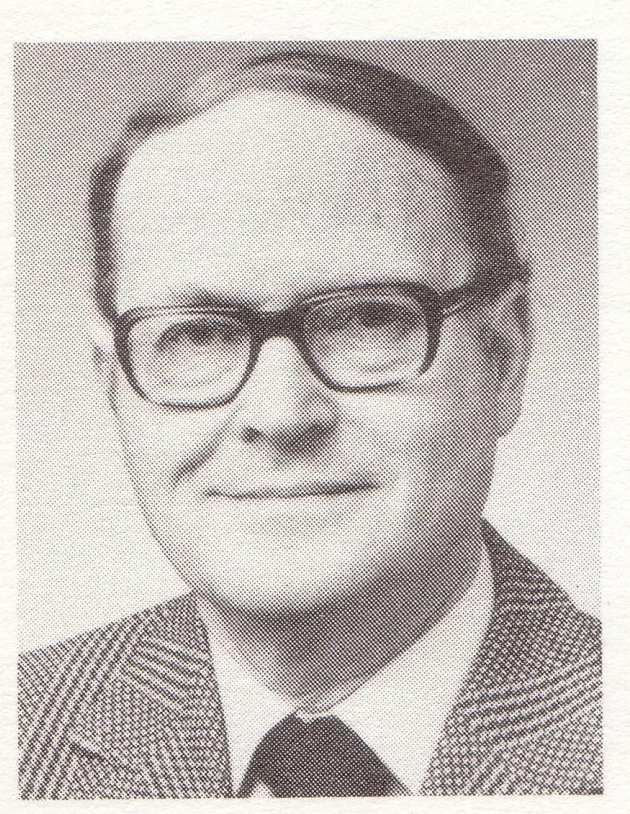 Following the Huddie Report on non scientific subjects at Imperial, the Department of Social and Economic Studies was founded Industrial Sociology and Economics. Aubrey Silberston (pictured right) held the first Chair of Economics, Dorothy Wedderburn, Professor of Industrial Sociology was the first Head of Department.
Following the Huddie Report on non scientific subjects at Imperial, the Department of Social and Economic Studies was founded Industrial Sociology and Economics. Aubrey Silberston (pictured right) held the first Chair of Economics, Dorothy Wedderburn, Professor of Industrial Sociology was the first Head of Department.
1978 - 4 Year Engineering Course began
Recommended by the Dainton report (Dainton picture left), increasing the length of the Engineering course was designed to expand students possibilities in obtaining managerial posts in industry by adding a year of study in industrial, social and economic studies. This was 'to produce engineers of a very high quality with an understanding of engineering in its managerial, social and economic context and able to advance to responsible positions in manufacturing industry'. Universities made bids for University Grants Committee funds for this and Imperial was one of those accepted.
David Huddie had come to similar conclusions as to the need for expansion studies from his in-depth investigation of Imperial and its courses.
1980 - Humanities Department opened
The Humanities Department was formed from the Associated Studies and History of Science with the first Head of Department being Professor David Raphael, a Philosopher.
1980 - Joint course with Royal College of Art in Engineering Design established
The Department of Mechanical Engineering launched collaboration with the Royal College of Art Industrial Engineering School.
1985 - City & Guilds Centenary celebrations
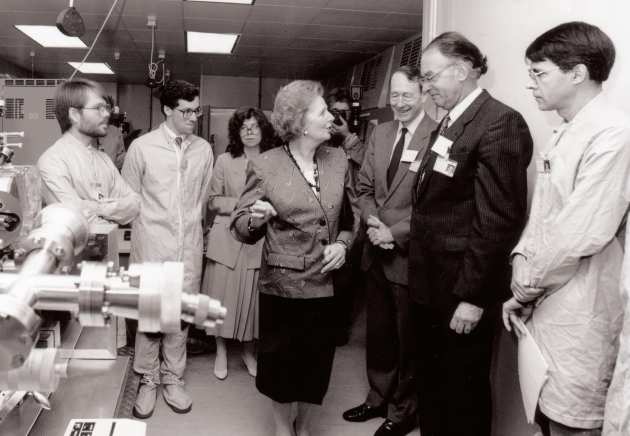 In 1985, the City & Guilds College celebrated its Centenary.
In 1985, the City & Guilds College celebrated its Centenary.
The festivities included a visit by Margaret Thatcher to the College, and a major exhibition entitled Tech 2000.
1985 - Honda Wind Tunnel opened
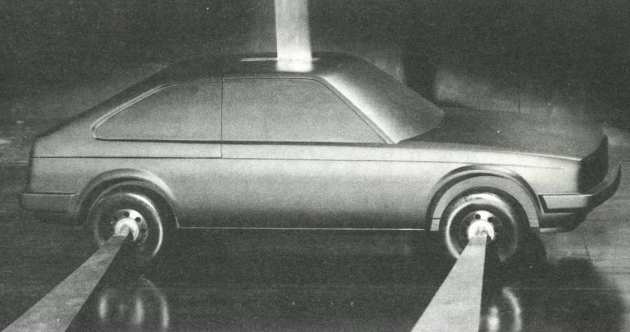 The Aeronautics Department has developed expertise in testing vehicle aerodynamics, including the Bluebird of Donald Campbell and the Formula 1 racing car companies.
The Aeronautics Department has developed expertise in testing vehicle aerodynamics, including the Bluebird of Donald Campbell and the Formula 1 racing car companies.
In 1982, the Honda R&D Division agreed a five year contract for the construction of a £700,000 wind tunnel specifically for studying vehicle aerodynamics with the capability of simulating cross winds and ground effects.
1988 - Imperial merges with St Mary's Hospital Medical School
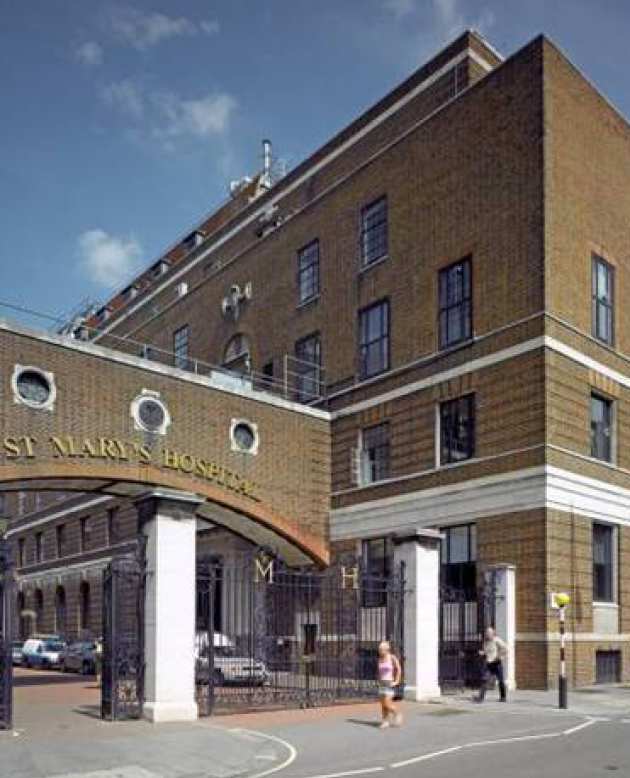 In 1988, Imperial College of Science, Technology & Medicine was formed through the merger of the College with St Mary's Hospital Medical School. A joint message from Imperial's then Rector Sir Eric Ash and the then Dean of St Mary's Professor Peter Richards states:
In 1988, Imperial College of Science, Technology & Medicine was formed through the merger of the College with St Mary's Hospital Medical School. A joint message from Imperial's then Rector Sir Eric Ash and the then Dean of St Mary's Professor Peter Richards states:
"The merger of our institutions was inspired by a vision of the great advances in science and medicine we could make together. The past experience of Imperial College is that students are enthused by biomedical topics and show great interest in undertaking research in this area both as undergraduates and postgraduates. St Mary's is similarly spurred by the creative opportunity of ideas within one institution.
We are confident of the rich potential for development in Clinical Ophthalmology and Visual Science. Also of the central role of the Centre for Biological and medical Systems as the spur and focus to harness the complementary skills and interests of the enlarged Imperial College of Science, technology and Medicine. The key to our success in the biomedical field lies in bringing together multidisciplinary teams with established records of achievements. We undertake to build a team who will keep Imperial College of Science, Technology and medicine at the international forefront of biomedical research and teaching."
1995 - Merger with the National Heart & Lung Institute at Royal Brompton
The National Heart and Lung Institute's merger with Imperial in 1995 makes it one of the founding divisions of what later became the School of Medicine. It now carries out pioneering research on all aspects of heart, lung cardiovascular disease, with increasing emphasis on interdisciplinary work in the areas of biomedicine, biophysics and bioengineering.
The merger of the National Heart and Lung Institute in 1995 with Imperial College marked another step in the development of the Institute from its beginnings in the nineteenth century and subsequent mergers with: The Hospital for Consumption and Diseases of the Chest 1841, later the Brompton Hospital and its sister hospital in the East End, the London Chest Hospital; The National heart Hospital; The Institute of Cardiology; The Brompton Hospital Medical School and the Institute of Diseases of the Chest.
1996 - Imperial wins University Challenge
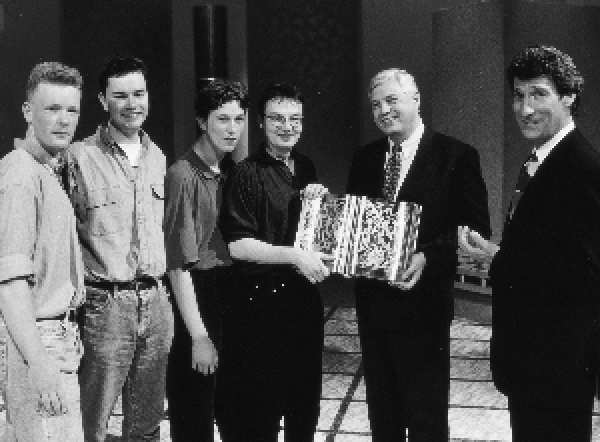 During the Jeremy Paxman era of the popular and intellectual UK quiz show University Challenge, Imperial teams have fared well, becoming series champions twice and runners up once. Along with Magdalen College Oxford, Imperial is one of only two institutions to have won more than one series, and is one of only five non-Oxbridge Colleges in the UK to have won at all.
During the Jeremy Paxman era of the popular and intellectual UK quiz show University Challenge, Imperial teams have fared well, becoming series champions twice and runners up once. Along with Magdalen College Oxford, Imperial is one of only two institutions to have won more than one series, and is one of only five non-Oxbridge Colleges in the UK to have won at all.
In 1996, captain Mark Pallen (PhD Biochemistry 1997), along with team mates Jim Totty (MSc Physics 1992, PhD 1996), Nick Bradshaw (PhD Electrical Engineering 1996) and Chris Harrison (MSc Computing 1996) stormed to victory, beating LSE in the final 275 to 220.
Five years later, the 2001 team (pictured here) became the second Imperial team to become series champions, defeating St John's College, Oxford, by 250 to 195. The team, captain Gavin Estcourt (MSc Computing 2000), John Douglas (PhD Civil Engineering 2001), Siegfried Hodgson (Computing 2001), and Alexander Campbell (Science Communication 2000) received the trophy from Poet Laureate Andrew Motion.
The following year, the Imperial team again reached the series final, but was beaten in a close match by Somerville College, Oxford. Despite its defeat, the team was sent a bottle of champagne by host Jeremy Paxman, who described its final performance as both catastrophic and courageous.
1997 - Imperial College School of Medicine formed
In 1997 the Imperial College School of Medicine was formed, the product of a series of mergers with leading London medical schools. It is now one of Europe's largest medical institutions, with over 1,500 postgraduates in the Graduate School of Life Sciences and Medicine and more than 300 new medical undergraduates admitted each year.
http://www.imperial.ac.uk/P1839.htm
1998 - Opening of the Sir Alexander Fleming Building by Her Majesty The Queen
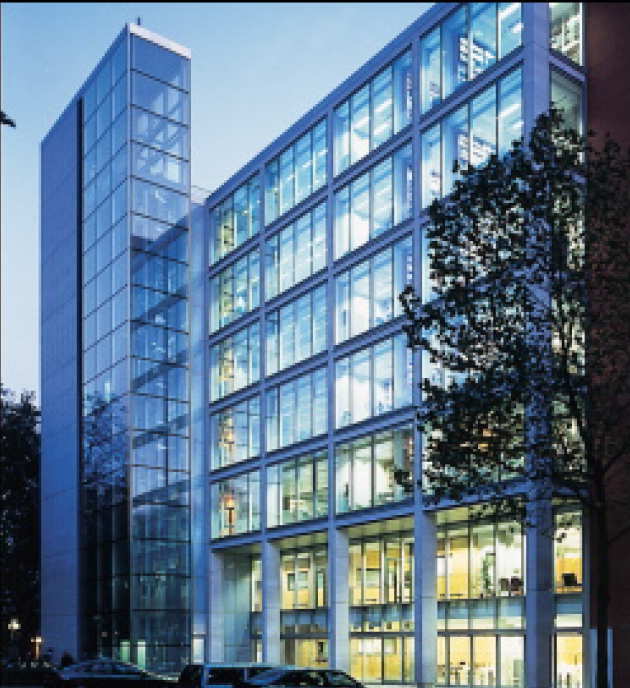 Opened in October 1998 by Her Majesty The Queen, the Sir Alexander Fleming Building provides purpose-build headquarters for the College's medical and biomedical research.
Opened in October 1998 by Her Majesty The Queen, the Sir Alexander Fleming Building provides purpose-build headquarters for the College's medical and biomedical research.
Designed by Sir Norman Foster and Partners, it received a Royal Institute of British Architects award in 1999 and includes an installation by Danish artist Per Arnoldi in its atrium.
- Watch the opening ceremony in RealPlayer.
1998 - Academic Opportunities Committee established
The Academic Opportunities Committee was established in 1998 as a Rector's Advisory Committee to ensure a 'level playing field' for women academics at Imperial College by removing barriers that may exist in appointment or career advancement, and to ensure that the numbers of such qualified women in the College are as high as possible.
2000 - Merger with Wye College
Wye College merged with Imperial College London on 1 August 2000.
Founded in 1447 as the College of St Gregory and St Martin by Cardinal John Kempe, initially as a college for training priests, Wye College subsequently had uses as a private residence, grammar school and charity school.
In 1894, the South Eastern Agricultural College was established which became the School of Agriculture within the University of London four years later.
Throughout the 20th Century Wye, based near Ashford, Kent, had an international reputation for research-led teaching in biological sciences, the environment, agricultural economics and business management, agriculture and horticulture. It was also home to an award-winning Distance Learning Programme, offered in conjunction with the University of London.
2000 - Merger with Kennedy Institute
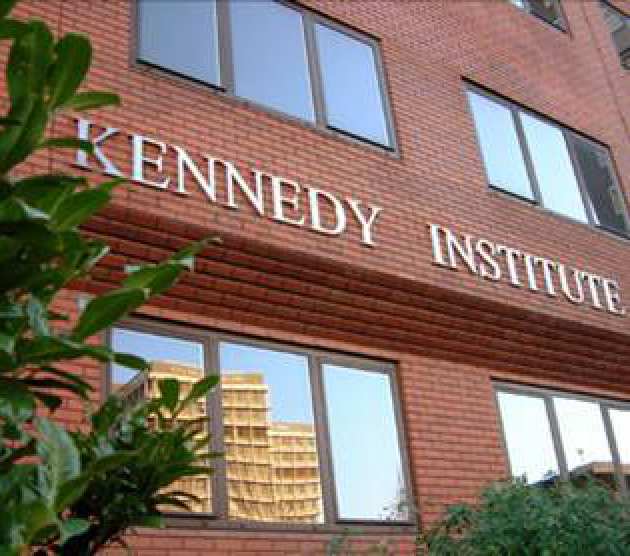 On 1 August 2000, the Kennedy Institute of Rheumatology merged with Imperial College, becoming the ninth division of the Imperial College School of Medicine.
On 1 August 2000, the Kennedy Institute of Rheumatology merged with Imperial College, becoming the ninth division of the Imperial College School of Medicine.
Its primary focus was on basic and clinical research into the aetiology of rheumatoid and osteoarthritis and to develop preventative and therapeutic interventions.
Research at the Kennedy Institute resulted in the development of anti-TNF therapy for the treatment of rheumatoid arthritis by Professors RavinderMaini and Marc Feldmann, for which they were awarded the 2000 Crafoord Prize by the Royal Swedish Academy of Sciences and the 2003 Lasker Award, known as America's Nobel.
2001 - Entrepreneurship Centre launched
Tanaka Business School's Entrepreneurship Centre was launched in January 2001, and immediately gained a reputation as one of Europe's most accomplished centres for the teaching and practical application of entrepreneurial ideas.
At the outset the Centre focused on new venture creation in technology sectors.
2002 - Schistosomiasis Control Initiative established
In July 2002, the Bill & Melinda Gates Foundation gave a grant of $30 million (£20 million) to establish the Schistosomiasis Control Initiative (SCI), a partnership at Imperial College London including the foundation, the World Health Organisation and the Harvard School of Public Health.
As of November 2014, the programme, led by Professor Alan Fenwick, has treated over 30 million children and adults in high risk situations, as well as providing health education and monitoring. The SCI provides a model for the successful control of this parasitic disease, which threatens approximately 600 million people in regions where water supply and sanitation are inadequate.
http://www.imperial.ac.uk/college.asp?P=3529
2003 – Imperial faculty structure established
Imperial adopts a Faculty structure, establishing the new Faculties of Engineering, Medicine, Life Sciences and Physical Sciences (the latter two merging to form the Faculty of Natural Sciences in 2005) alongside the Tanaka Business School.
2004 - Opening of College Main Entrance and Tanaka Business School
Imperial's new Main Entrance and accommodation for the Tanaka Business School were officially opened by Her Majesty The Queen, accompanied by The Duke of York, on 24 June 2004.
Made possible by a £27 million pledge by technology investor and Imperial alumnus Dr Gary Tanaka, the landmark building, designed by Foster and Partners, created a highly-visible entrance to the College on Exhibition Road.
Welcoming Her Majesty, Sir Richard said:
"The building in which we now stand represents another step in bringing to fruition the far-sighted vision and wisdom of your ancestor, Prince Albert. Far ahead of his time, he recognised that people would live better, in a more prosperous country, if art and science were properly directed to useful purposes.
"Innovative science and scientists are essential to successful industry. It is entirely fitting, therefore, that our Tanaka Business School is at the very portal of the College. We compete on a global stage, and to have a building, as splendid as this, on one of London's great thoroughfares, sends a message to the world about the role of learning and discovery in this fast changing world and Imperials contribution to that."
2005 - Demolition of Southside
The replacement of the outdated Southside student accommodation, opened in 1963 and increasingly unable to meet residents' requirements, suffered from concrete maintenance problems and lack of adaptability for present student requirements. In 2005 a project began to develop the new Southside, designed to be in keeping with the local area and providing high quality accommodation for students with a range of budgets. It was opened in October 2007.
2005 - Launch of Imperial as One
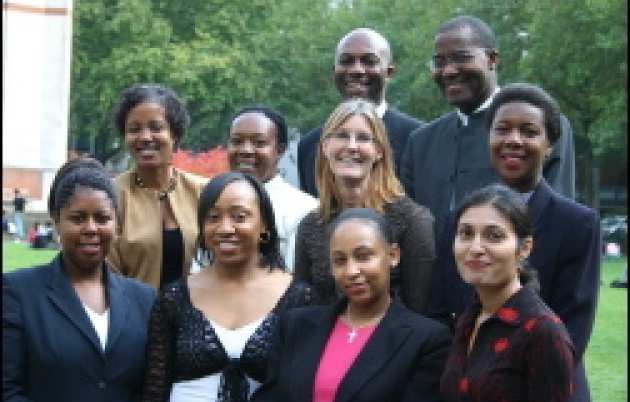 Imperial as One was launched in July 2005 as an initiative to promote equality and diversity. It is an advisory group, made up of black and minority ethnic (BME) staff, designed to take a leading role in supporting and promoting an inclusive workplace culture of respect, opportunity, unity, transparency and equality. The group works to continually tackle and manage issues of racism, discrimination, fear and prejudice.
Imperial as One was launched in July 2005 as an initiative to promote equality and diversity. It is an advisory group, made up of black and minority ethnic (BME) staff, designed to take a leading role in supporting and promoting an inclusive workplace culture of respect, opportunity, unity, transparency and equality. The group works to continually tackle and manage issues of racism, discrimination, fear and prejudice.
2006 - Decision to withdraw from University of London
Imperial College London was a college of the University of London from 1908, awarding University of London degrees. Recognising Imperial College as a world-class research and teaching institution in its own right, on 14 July 2006
Imperial College's Council made the decision that Imperial should withdraw from the University of London and become a university, independent from any other organisation or structure. Imperial College's request to withdraw was agreed by the University of London's Council on 4 October 2006.
1 October 2007 – Imperial College Healthcare NHS Trust formed
The Imperial College Healthcare NHS Trust was created by merging St Mary’s NHS Trust and Hammersmith Hospitals NHS Trust. Through integrating the Trust with the College, the UK’s first Academic Health Science Centre was formed.
2007 – Grantham Institute for Climate Change established
The Grantham Institute for Climate Change was established at Imperial College in 2007 following a £12 million donation from Jeremy and Hannelore Grantham, through the Grantham Foundation for the Protection of the Environment.
The Institute is focused on understanding the radical climate changes occurring on Earth, how they affect human welfare and ecosystems and on developing the technological, market and policy solutions needed to mitigate and adapt to change at both a global and local level. The first Director of the Grantham Institute was Sir Brian Hoskins FRS.
2007 - Imperial celebrates its centenary
2007 - Independence from the University of London
2008 – Business School renamed
The name of the College’s business school was changed from Tanaka Business School to Imperial College Business School to emphasise that it is an integral part of the College. Imperial alumnus and benefactor Dr Gary Tanaka, after whom the School was formerly named, continues to be recognised for his generous support with the naming of the School's accommodation as 'The Tanaka Building'.
2008- RAE results
In 2008 Imperial College London was named home to the greatest concentration of research rated world-leading and internationally excellent amongst all UK universities, according to Research Assessment Exercise (RAE08) results.
73% of the College’s staff had their research judged as world-leading or internationally excellent (4* and 3*), the highest percentage of all UK multi-faculty universities.
The College had six of the UK’s top-rated research areas (4*) in Chemical Engineering; Civil Engineering; Epidemiology; Mechanical, Aeronautical and Manufacturing Engineering; History; and Pure Mathematics.
2009 – Wye Campus Closed
Following a decline in students studying agricultural-related courses the Department of Agricultural Sciences at Wye closed in 2004, with all academic activity ending in 2009.
September 2009 – College purchases land in White City
Imperial College London purchased the 7-acre Woodlands site in White City from the BBC for £28 million, and started planning towards the development of a new campus there, subsequently known as White City Campus.
15 January 2010 - Mayor opens restored Prince’s Gardens
The Mayor of London, Boris Johnson, visited the South Kensington Campus on to officially open the restored Prince’s Gardens, marking the culmination of a five year project. The £160 million investment witnessed the construction of seven new halls of residence and a state-of-the-art sports centre, plus the landscaping of the gardens themselves.
23 March 2010 – Opening of the Wohl Reach Out Lab
Imperial expanded its public engagement and outreach activities with the creation of the Wohl Reach Out lab, a state-of-the-art laboratory established to raise the aspirations and scientific literacy of young people of all abilities from a diversity of backgrounds, championed by Professor Lord Winston, Chair of Science and Society.
August 2011 – Kennedy Institute moves to the University of Oxford
Following the signing of an agreement by the College and the University of Oxford, staff in the Kennedy Institute of Rheumatology transferred to the University of Oxford. From 1 August 2011 the Kennedy Institute ceased to be part of the College.
April 2012 – College unveils new leadership structure
The College adopted a new leadership arrangement separating the responsibilities of the Rector between a President and the new role of Provost.
Imperial's Council, the governing body of the College, approved the change to the leadership structure for the College. The role of President has oversight of all functions at Imperial, but will also place greater emphasis on Imperial's external affairs in the UK and overseas, focused on building relationships with alumni, supporters, governments and industry. The Provost is responsible for advancing and delivering the College's core academic mission - education, research and translation.
May 2012 The inaugural Imperial Festival
Imperial held its first Imperial Festival, a 2 day celebration of the College’s achievements and activities. The event, an annual feature in the College calendar, includes opportunities for the general public and key stakeholders to meet researchers and discuss their work, witness hands on demonstrations and enjoy music, comedy, dancing and art.
September 2012 – Opening of Wood Lane Studios postgraduate accommodation at Imperial West
Phase one of the development of White City Campus was completed in September 2012, with the opening of the Wood Lane Studios on the northern section of the site. Wood Lane Studios, a complex of over 600 studio apartments for postgraduate students, welcomed its first residents in September 2012.
March 2013 – Brevan Howard Centre for Financial Analysis
The Brevan Howard Centre for Financial Analysis was created through a transformational gift of £20.1 million from Brevan Howard, one of Europe’s most prominent hedge funds, which was established by Imperial alumnus Alan Howard (MEng Chemical Engineering and Chemical Technology 1986).
The Brevan Howard Centre for Financial Analysis is designed to engage in cutting-edge research in financial market behaviour, and enhance the Imperial College Business School’s expertise in financial economics. The Centre serves as a bridge between the Business School and the world of business, aiming to develop a greater understanding and more efficient management of risk, and to promote investment and productivity.
June 2013 – Expansion of Imperial West
Imperial purchased 11.5 acres in White City to expand its new campus, White City Campus, taking the College’s total landholding for its new campus to approximately 25 acres. The plots form one contiguous site adjacent to the A40.
August 2013 first students enrol at the Lee Kong Chain School of Medicine in Singapore
The Lee Kong Chian School of Medicine (LKCMedicine) in Singapore, a joint initiative between Imperial and Nanyang Technological University (NTU), admitted its first cohort of students in August 2013. The 54 new students, who started a five year Bachelor of Medicine and Bachelor of Surgery (MBBS) degree in August 2013, will graduate with a joint degree awarded by both institutions. It is the first degree course from Imperial to have been developed and delivered overseas.
December 2014 – REF results
The College celebrated its best ever performance in a research assessment.
The Research Excellence Framework (REF) 2014 found that 91% of Imperial research was judged as “world-leading” or “internationally excellent” (4* and 3*) - the highest proportion of any major university. The College was also shown to have the UK’s greatest concentration of high-impact research.
Imperial demonstrated improvement in every REF research area. Nine of the College’s 14 research areas were ranked in the top three in the UK overall, with two taking the top spot: Public Health, Health Services & Primary Care, and Civil & Construction Engineering.
March 2015 – Dyson School of Design Engineering
The Dyson School of Design Engineering was created through a £12 million donation from the James Dyson Foundation, which was established by inventor and industrial designer Sir James Dyson. The School will teach a four year undergraduate Masters degree in Design Engineering, developed with Dyson engineers alongside other stakeholders to combine technical expertise with creativity.
-(1).jpg)